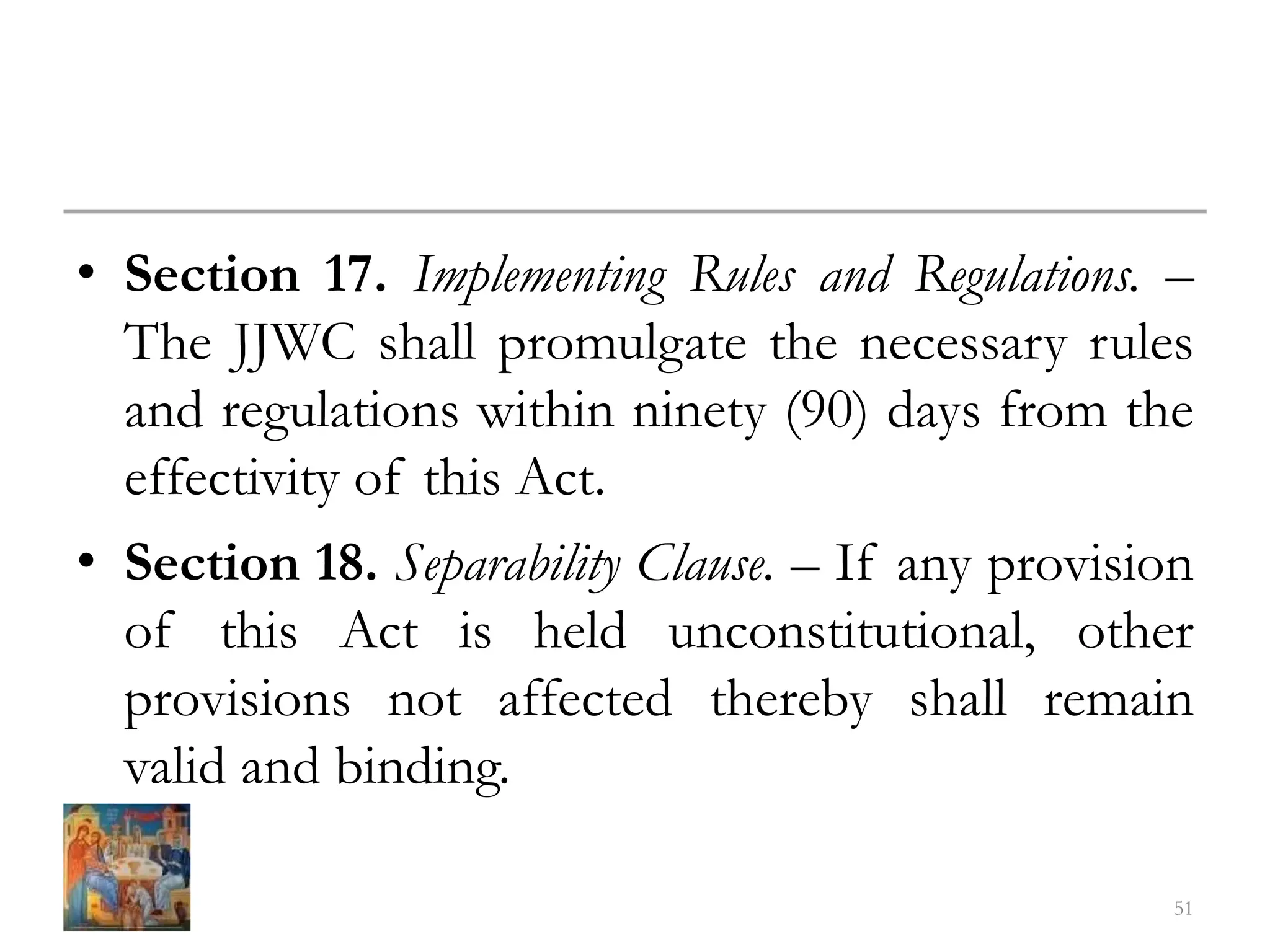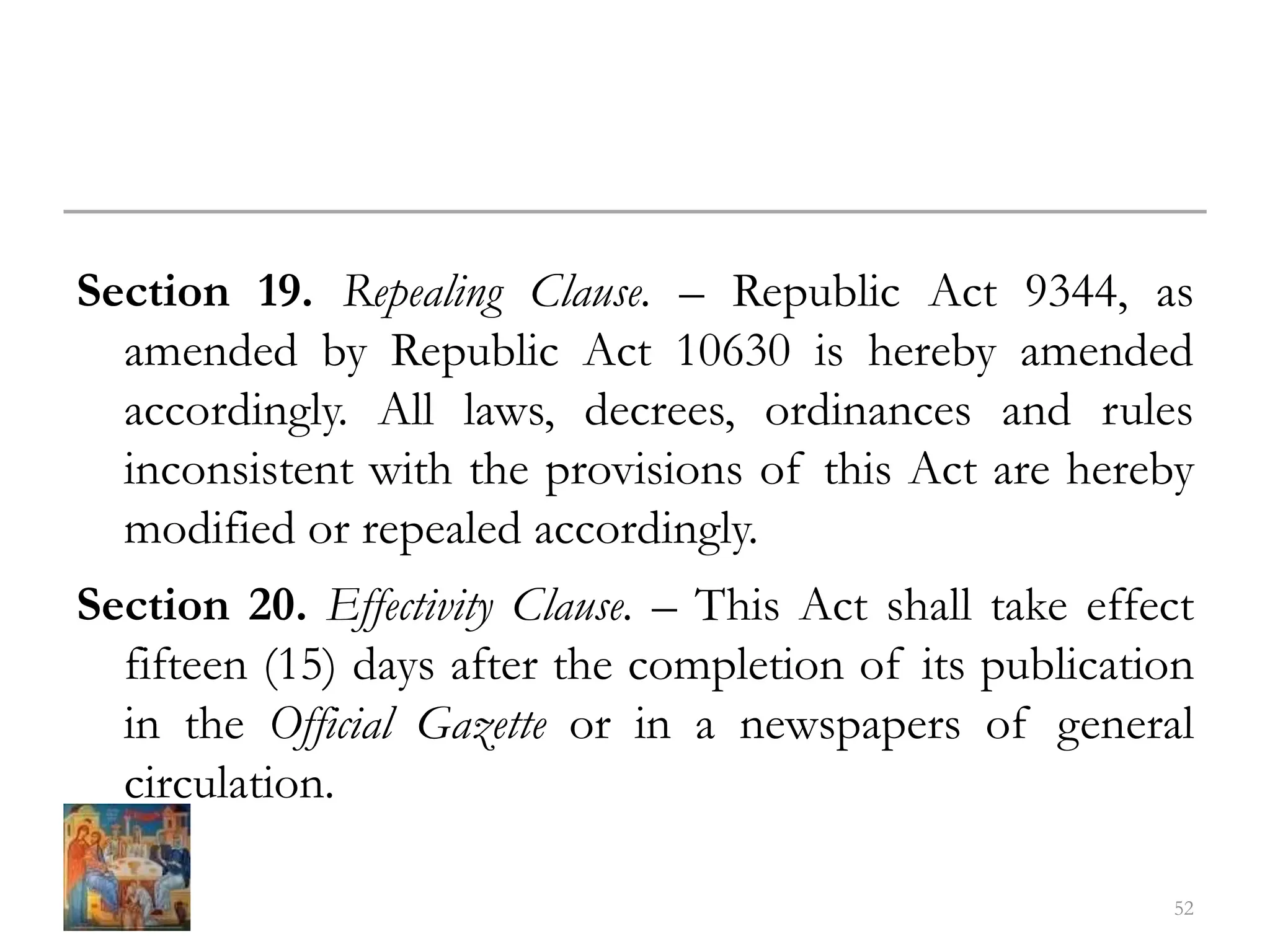House Bill No. 8858 proposes to amend the minimum age of criminal responsibility from 15 to 9 years and seeks to enhance the juvenile justice and welfare system. The bill aims to provide a comprehensive approach to addressing children in conflict with the law through intervention programs and community-based strategies, emphasizing restorative justice principles. However, there are concerns regarding the implications of lowering the age limit, including potential congestion of care facilities and the influence of older youths on younger offenders.
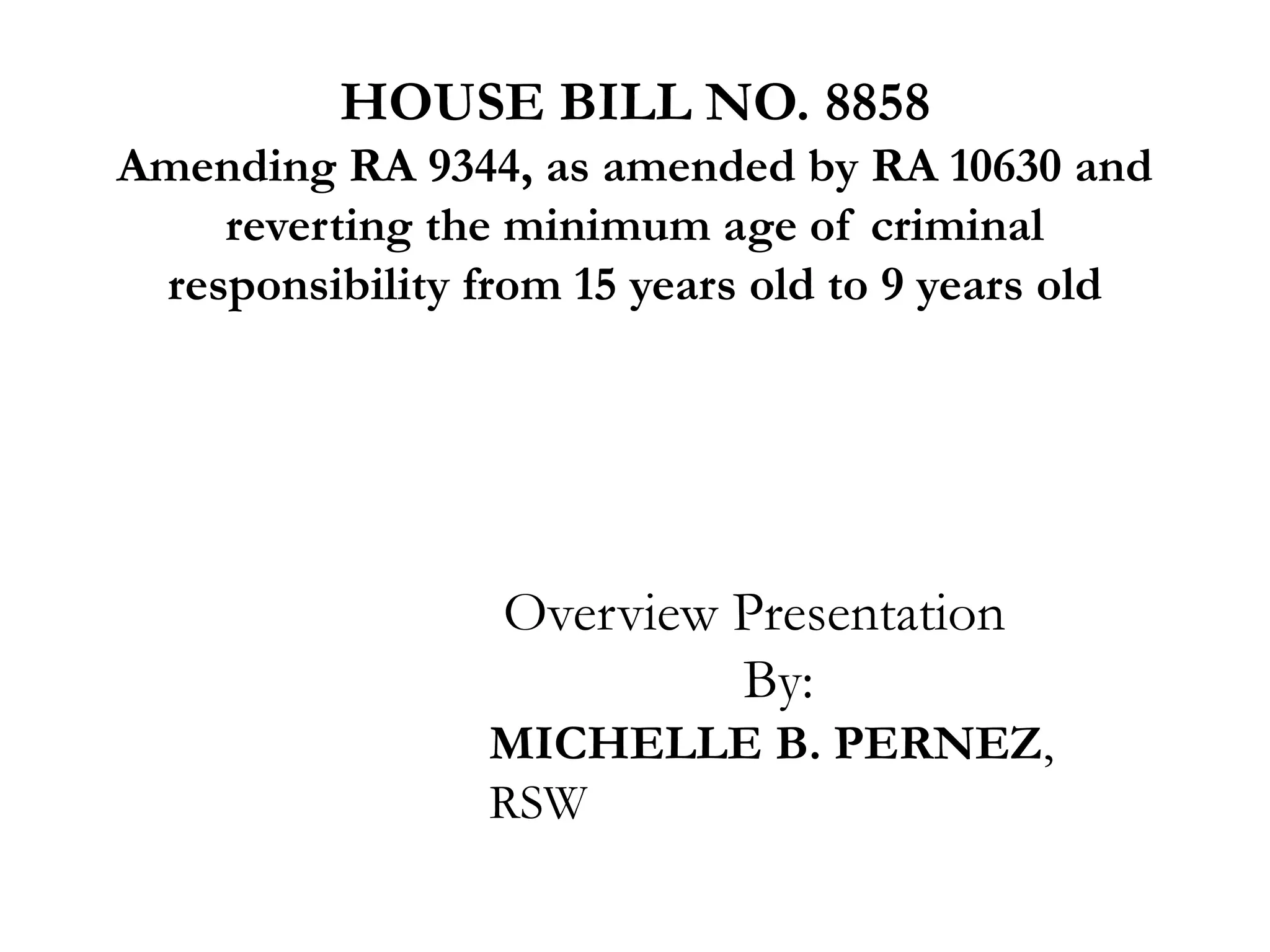
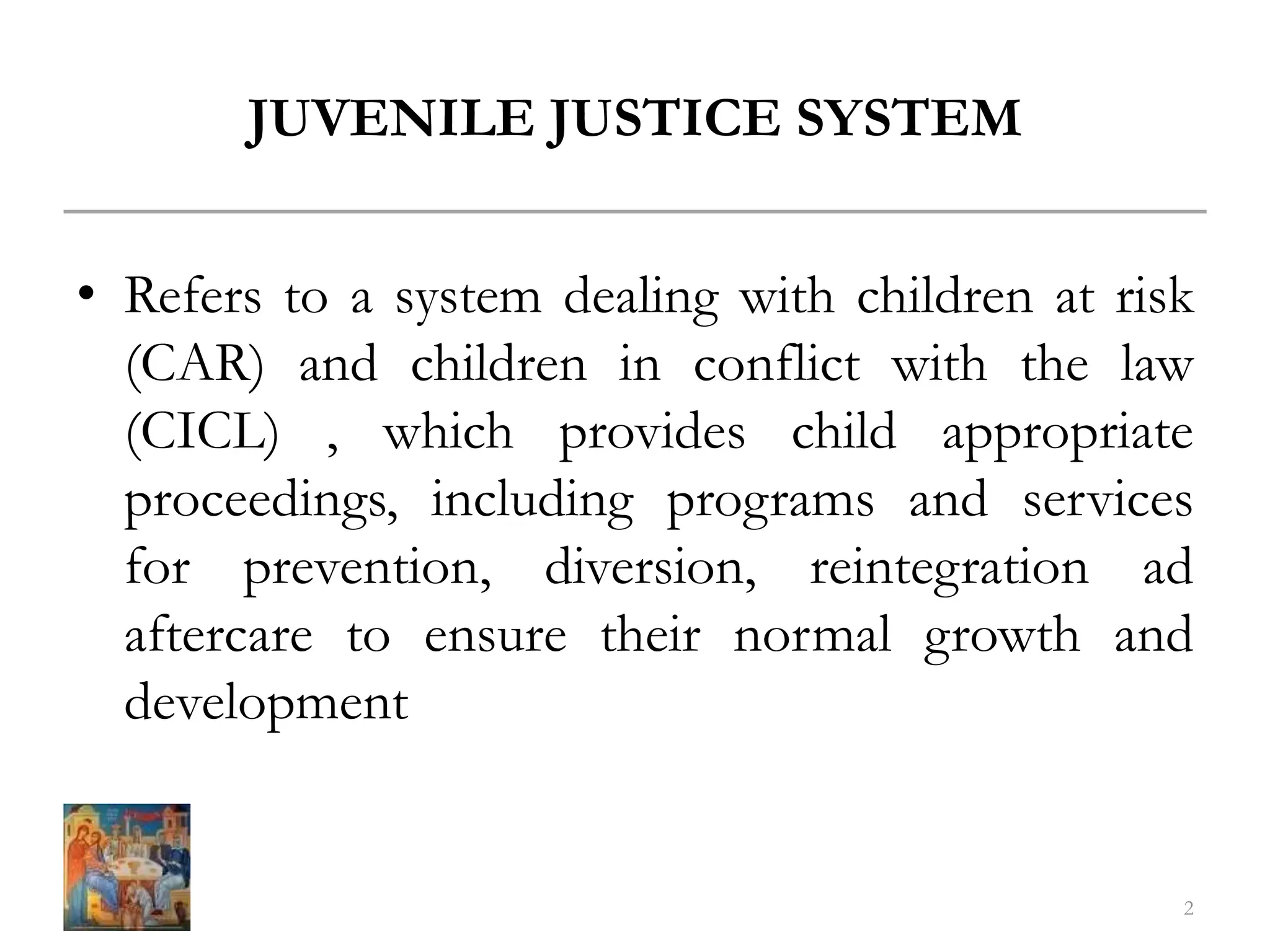
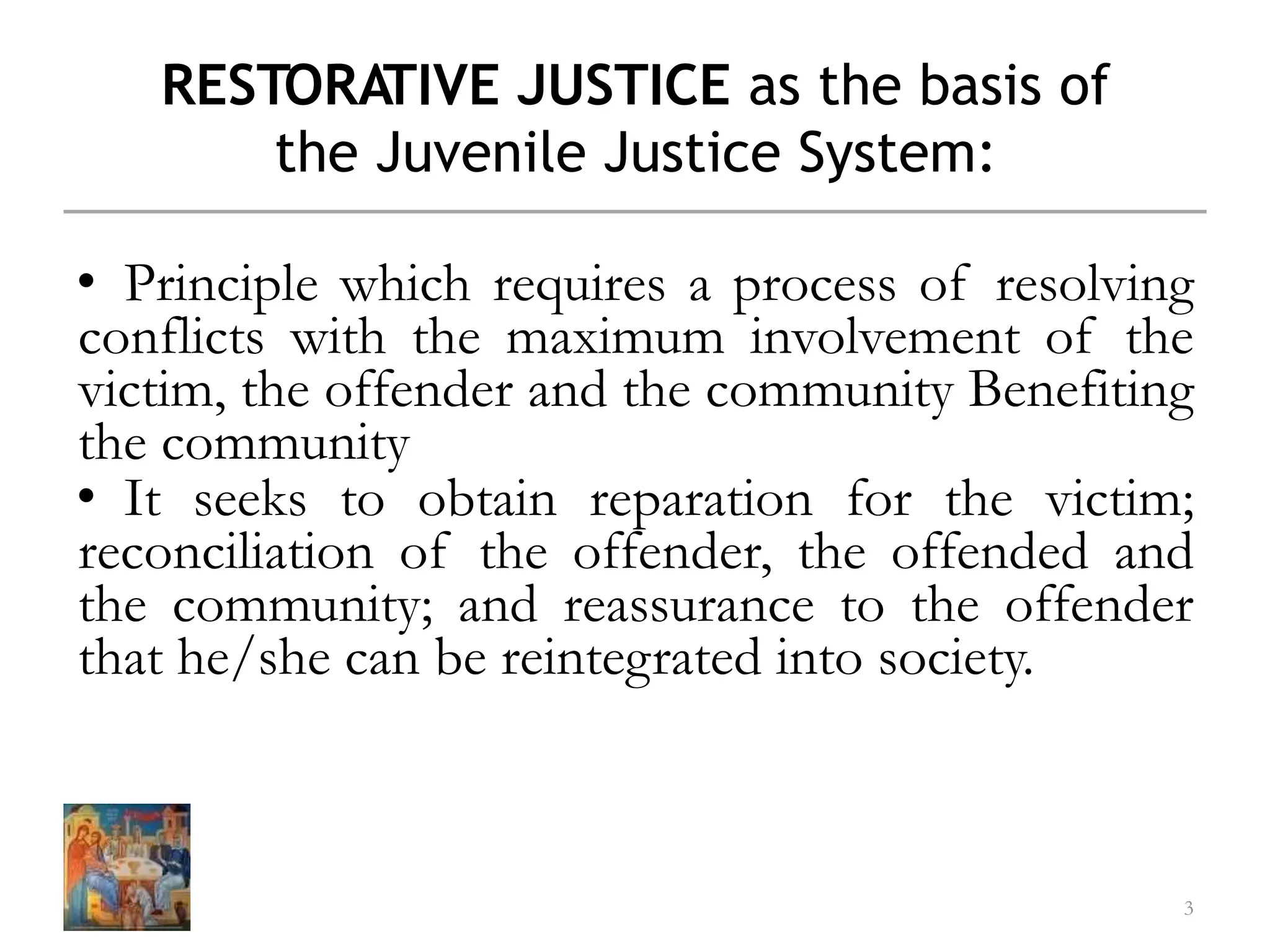
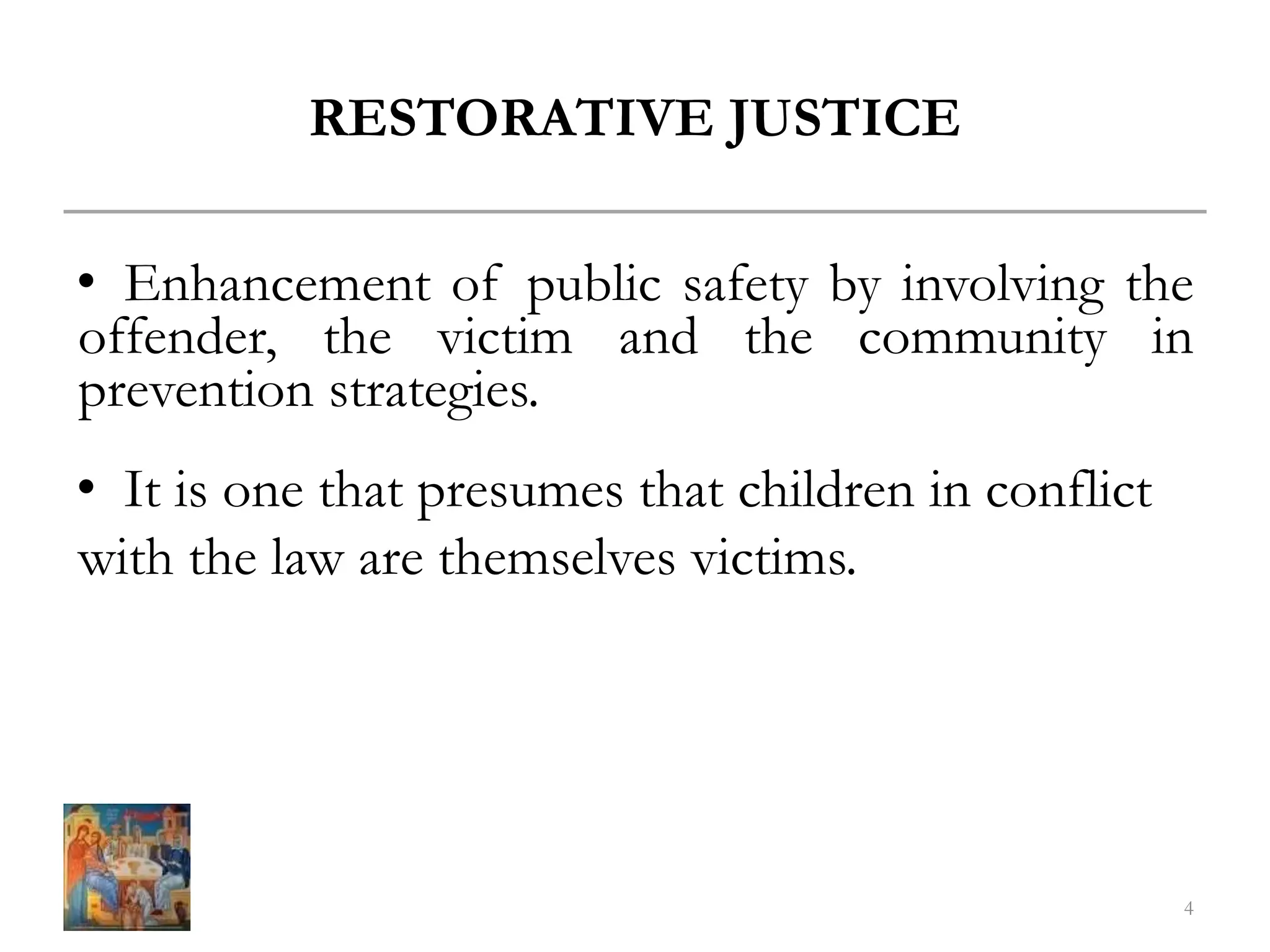
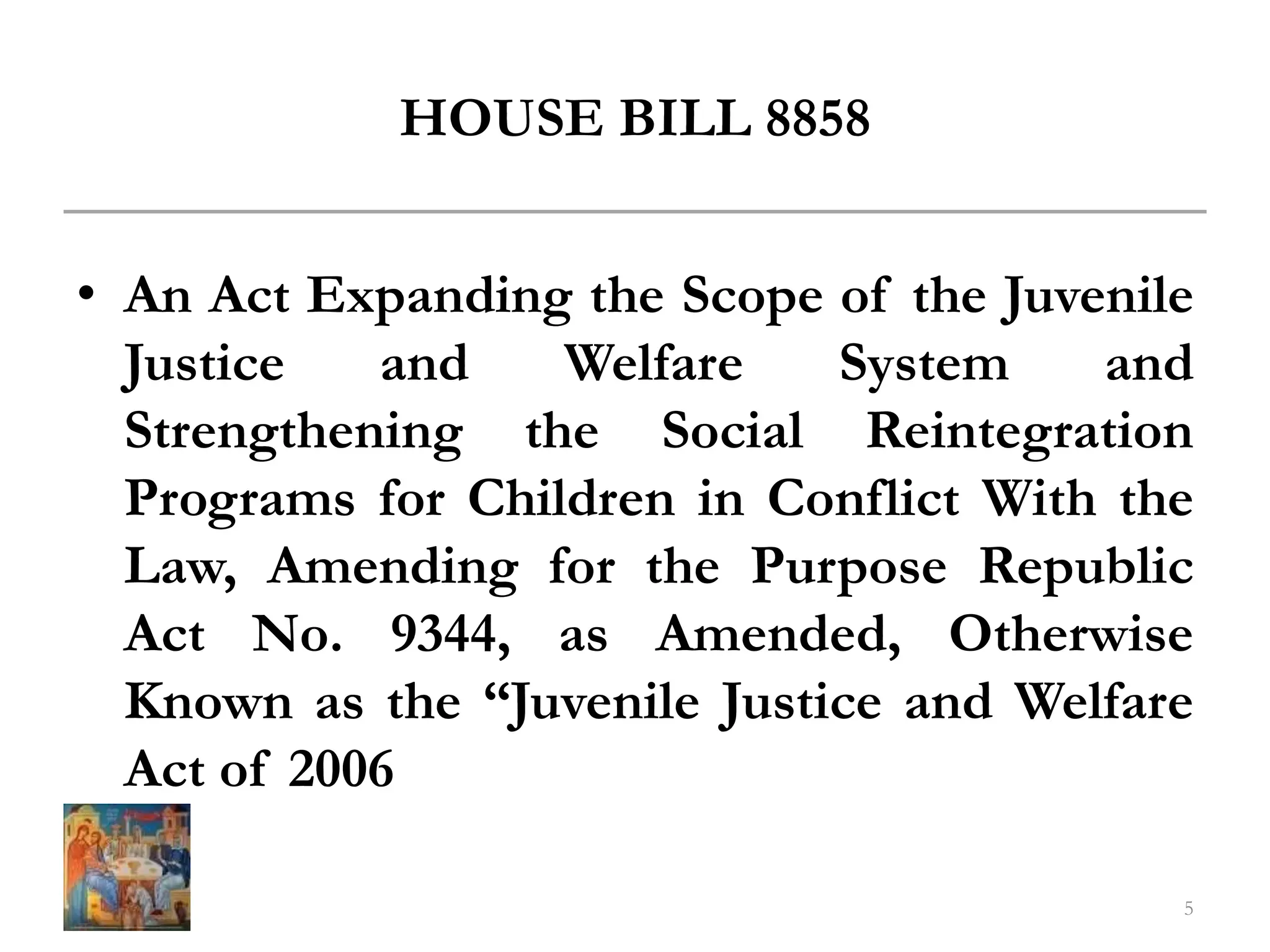
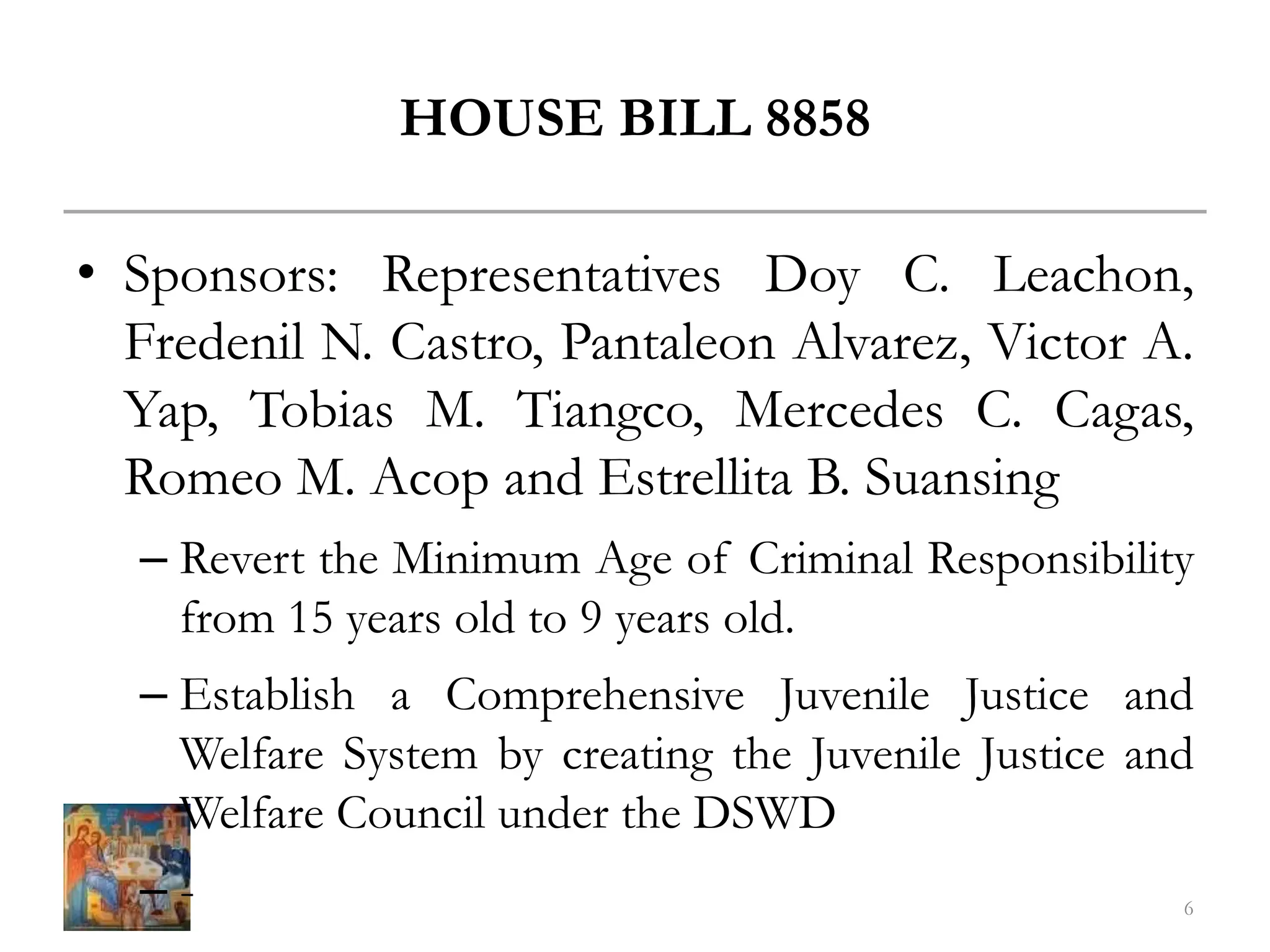
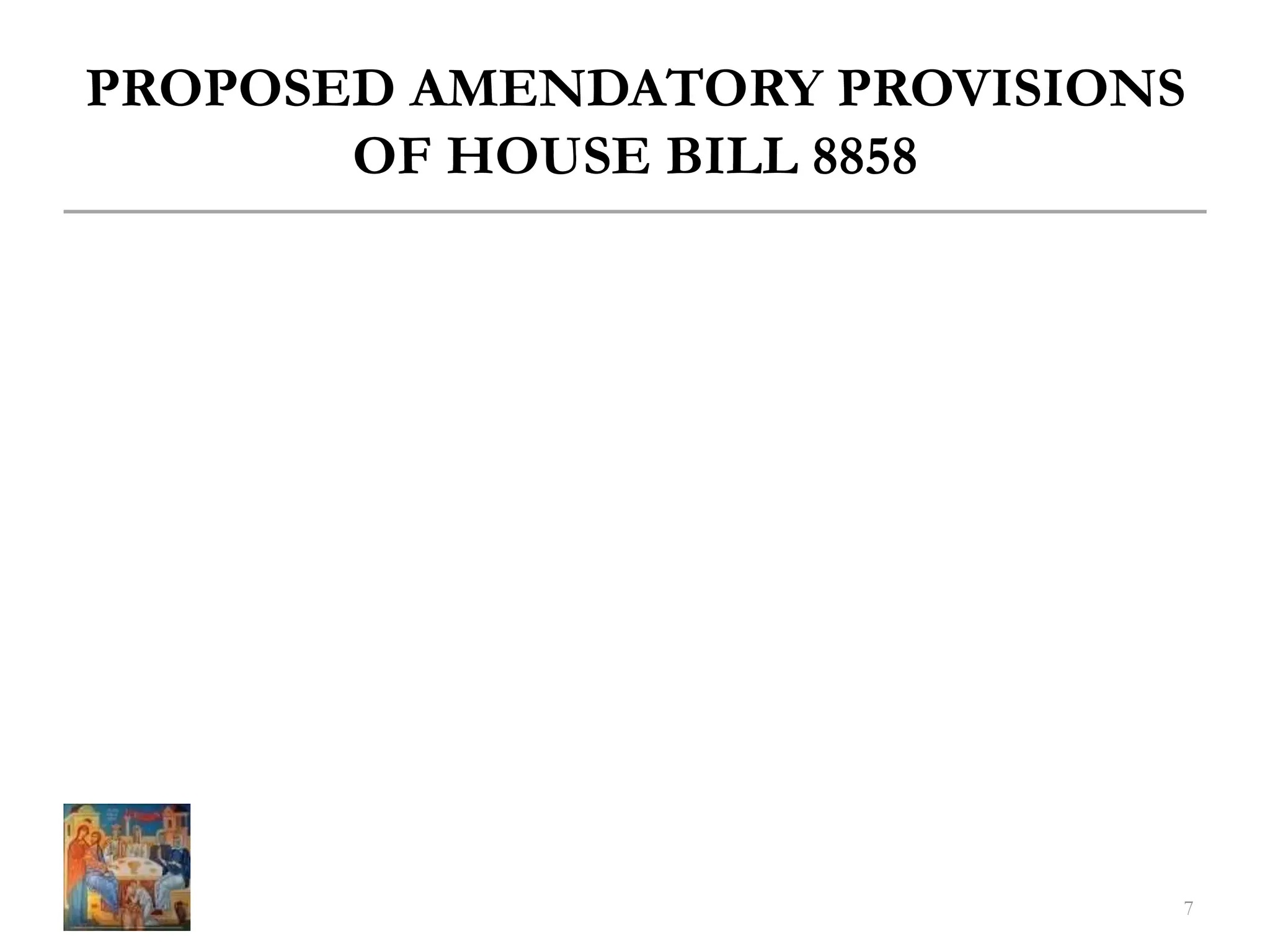

![SEC. 4. DEFINITION OF TERMS
"(s) ‘Bahay Pag-asa’ – refers to a 24-hour child-caring
institution established, funded and managed [by local
government units (LGUs)] THE DEPARTMENT OF
SOCIAL WELFARE AND DEVELOPMENT
(DSWD) and licensed and/or accredited non-government
organizations (NGOs) providing short-term residential care
for children in conflict with the law who are [above fifteen
(15)] NINE (9) YEARS OF AGE AND ABOVE but
below eighteen (18) years of age who are COMMITTED
FOR REHABILITATION OR awaiting court
disposition of their cases or transfer to other agencies or
jurisdiction.
9](https://image.slidesharecdn.com/powerpoint-role-of-proposedamendmentstojuvenilejusticeandwelfareact-240424130741-7accdb12/75/powerpoint-role-of-proposed-amendments-to-Juvenile-Justice-and-Welfare-Act-ppt-9-2048.jpg)

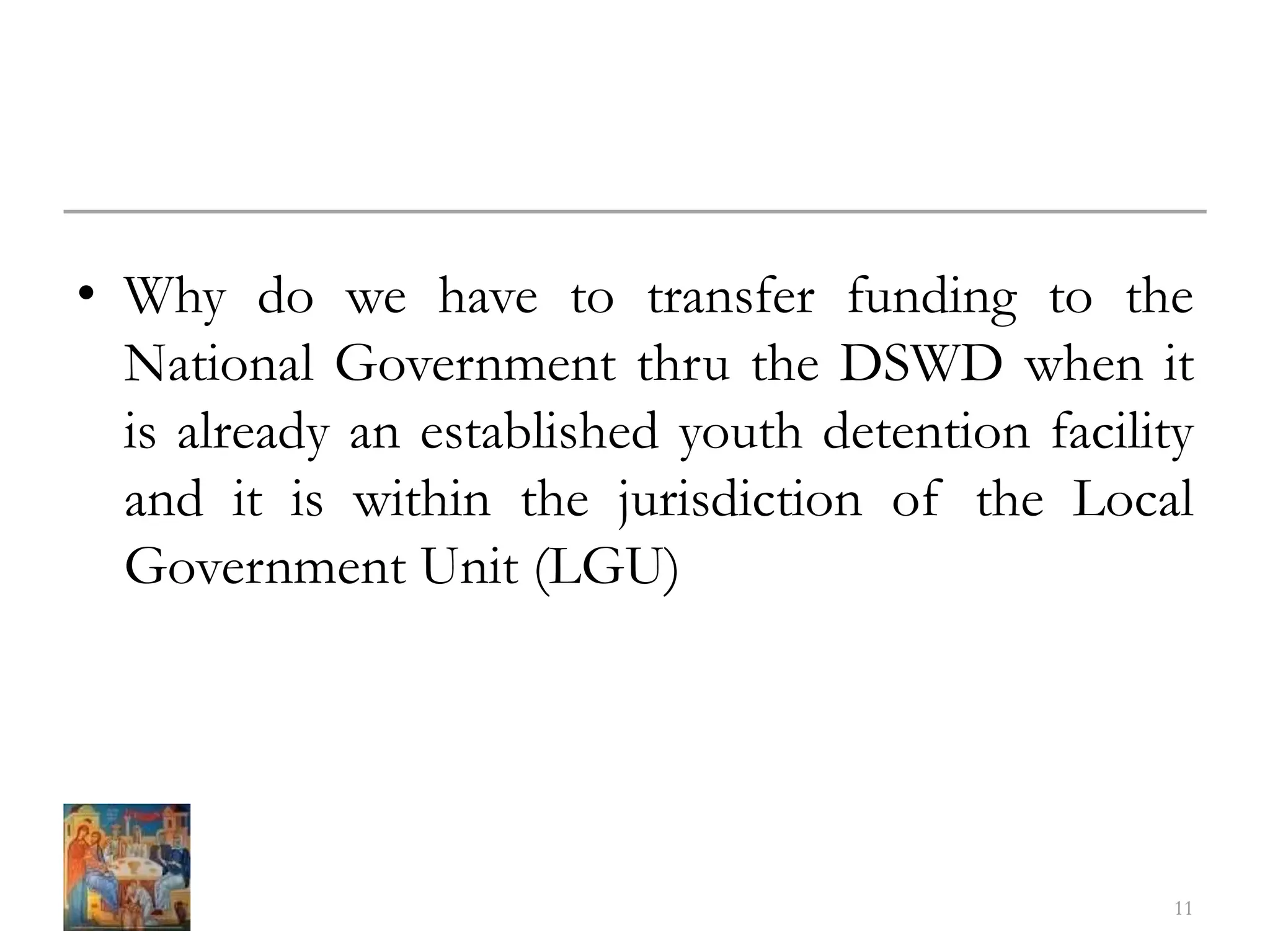
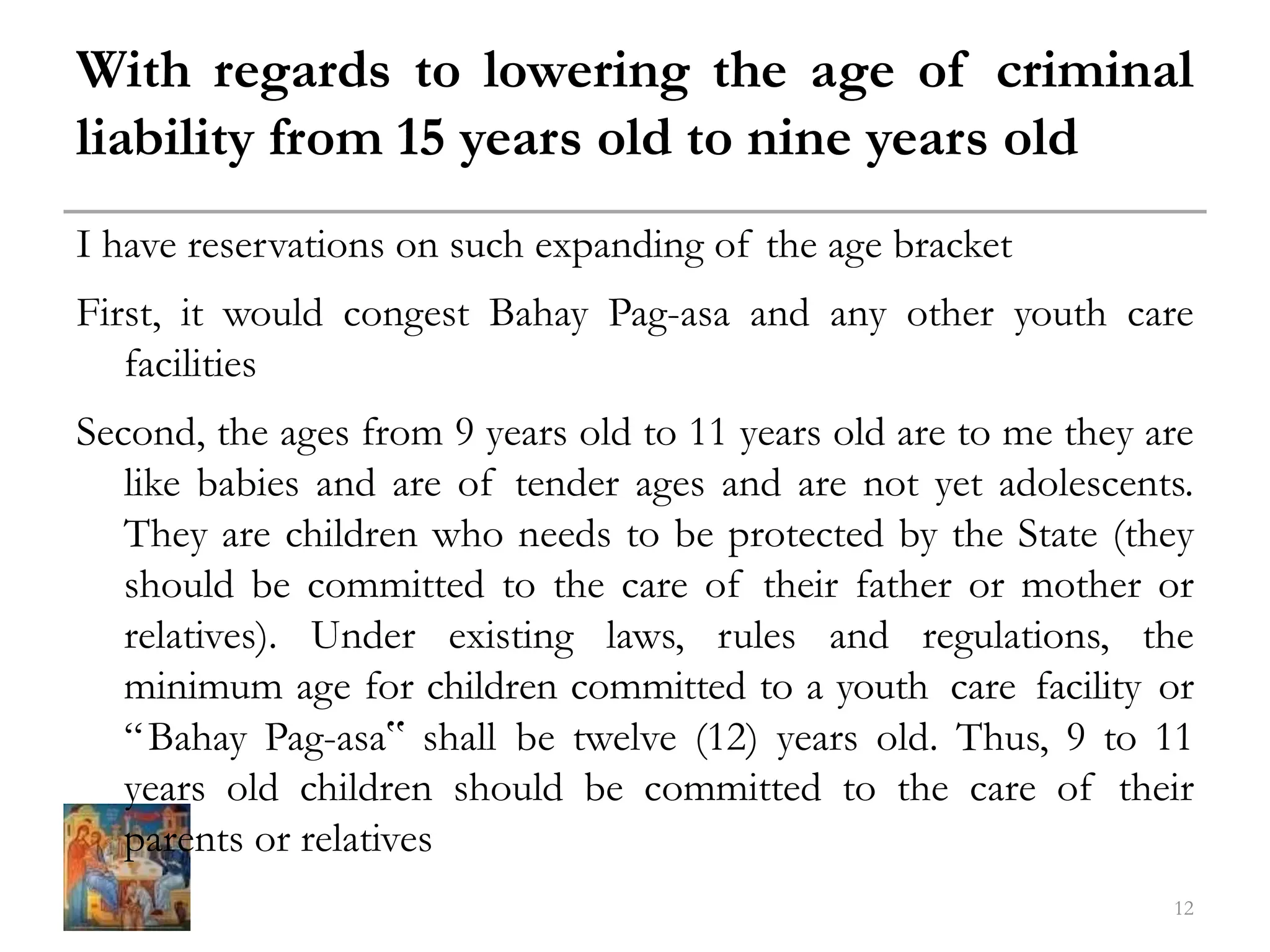
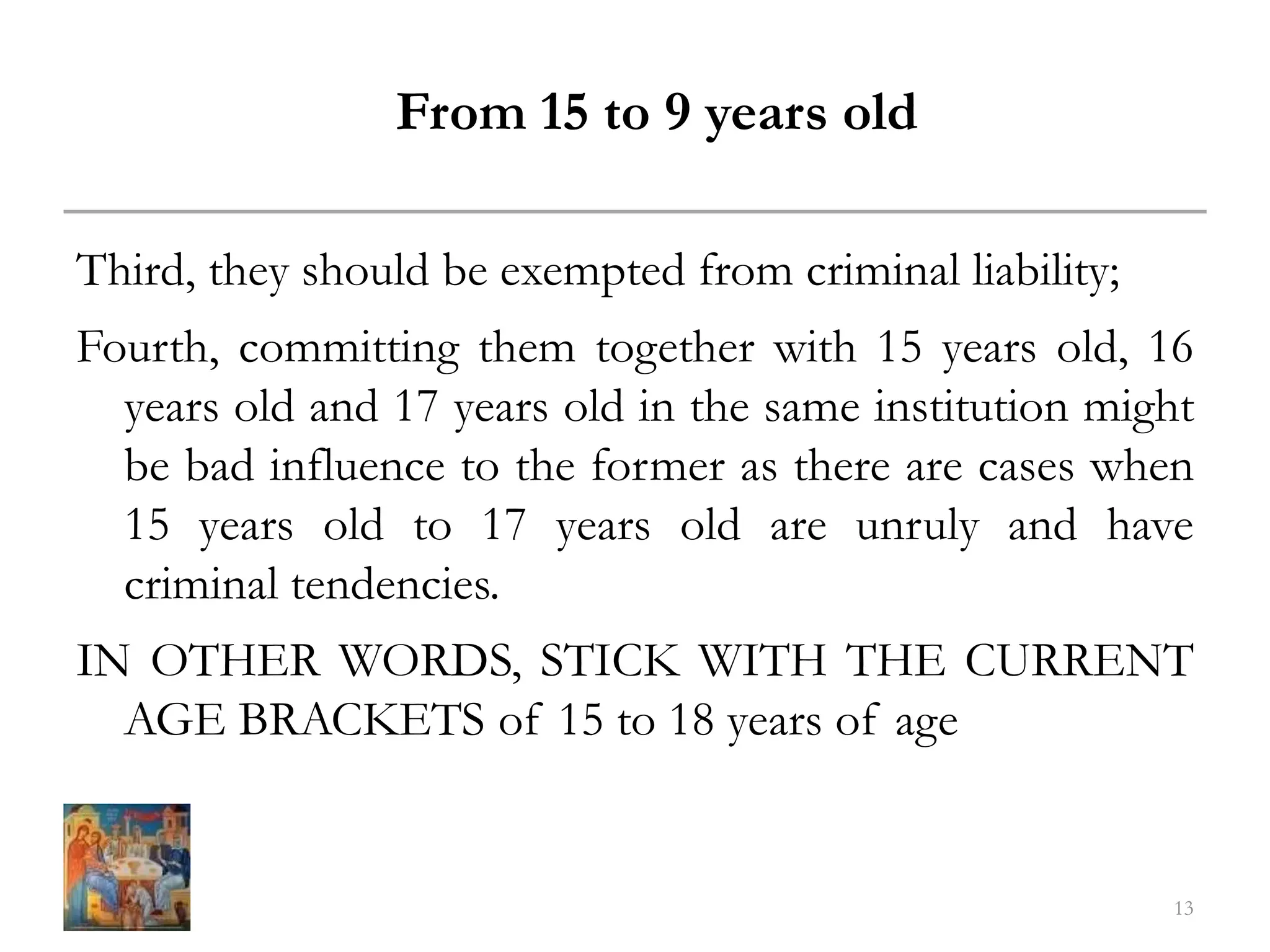
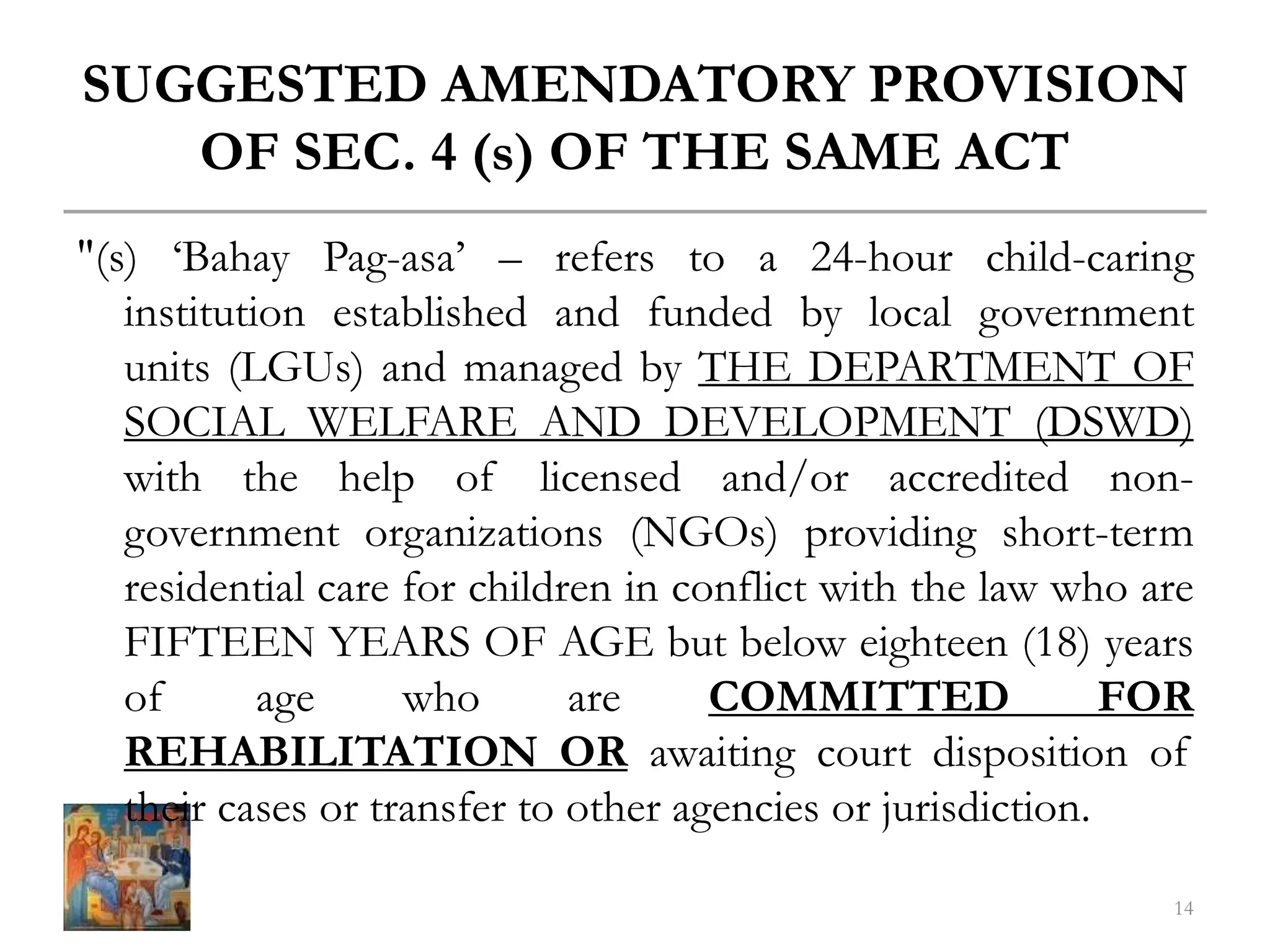
![Section 2. Section 6 of the same Act, as amended,
is further amended to read as follows:
“Sec. 6. Minimum Age of [Criminal]
Responsibility OF CHILDREN IN
CONFLICT WITH THE LAW – A child
[fifteen (15)] BELOW NINE (9) years of age
[or under] at the time of the commission of the
offense shall be exempt from criminal liability.
However, the child shall be subjected to an
intervention program pursuant to Section 20 of
this Act
• 15](https://image.slidesharecdn.com/powerpoint-role-of-proposedamendmentstojuvenilejusticeandwelfareact-240424130741-7accdb12/75/powerpoint-role-of-proposed-amendments-to-Juvenile-Justice-and-Welfare-Act-ppt-15-2048.jpg)
![“A child is deemed to be [fifteen (15)] NINE (9) years of
age on the day of the [fifteenth] NINTH anniversary of
[his/her] THE CHILD’S birth date.
“A child [above fifteen (15)] NINE (9) years OF AGE AND
ABOVE but below eighteen (18) years of age shall
likewise be exempt from criminal liability and be
subjected to an intervention program, unless [he/she]
THE CHILD has acted with discernment, in which case,
such child shall be subjected to the appropriate
proceedings in accordance with this Act.
• 16](https://image.slidesharecdn.com/powerpoint-role-of-proposedamendmentstojuvenilejusticeandwelfareact-240424130741-7accdb12/75/powerpoint-role-of-proposed-amendments-to-Juvenile-Justice-and-Welfare-Act-ppt-16-2048.jpg)
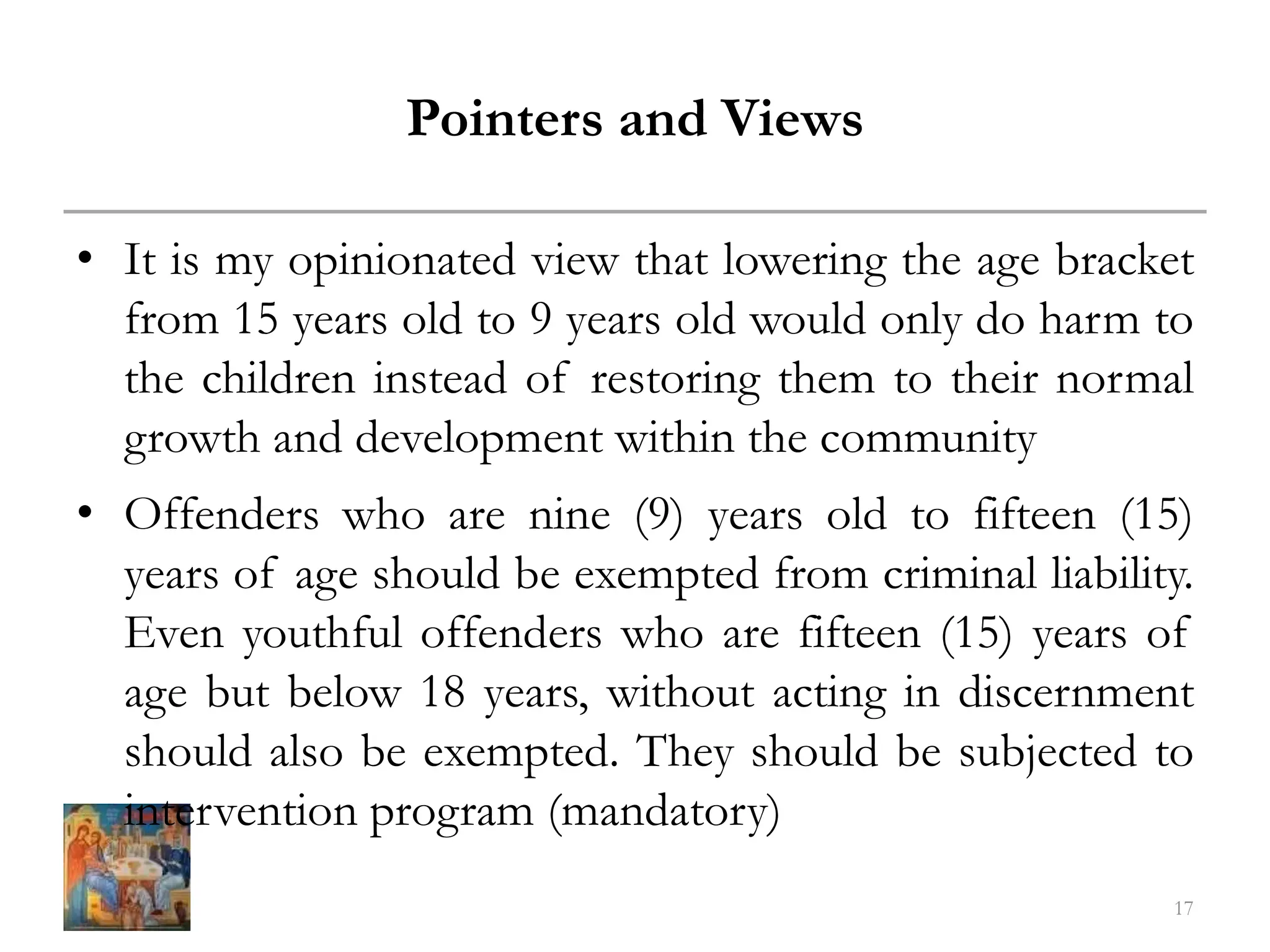

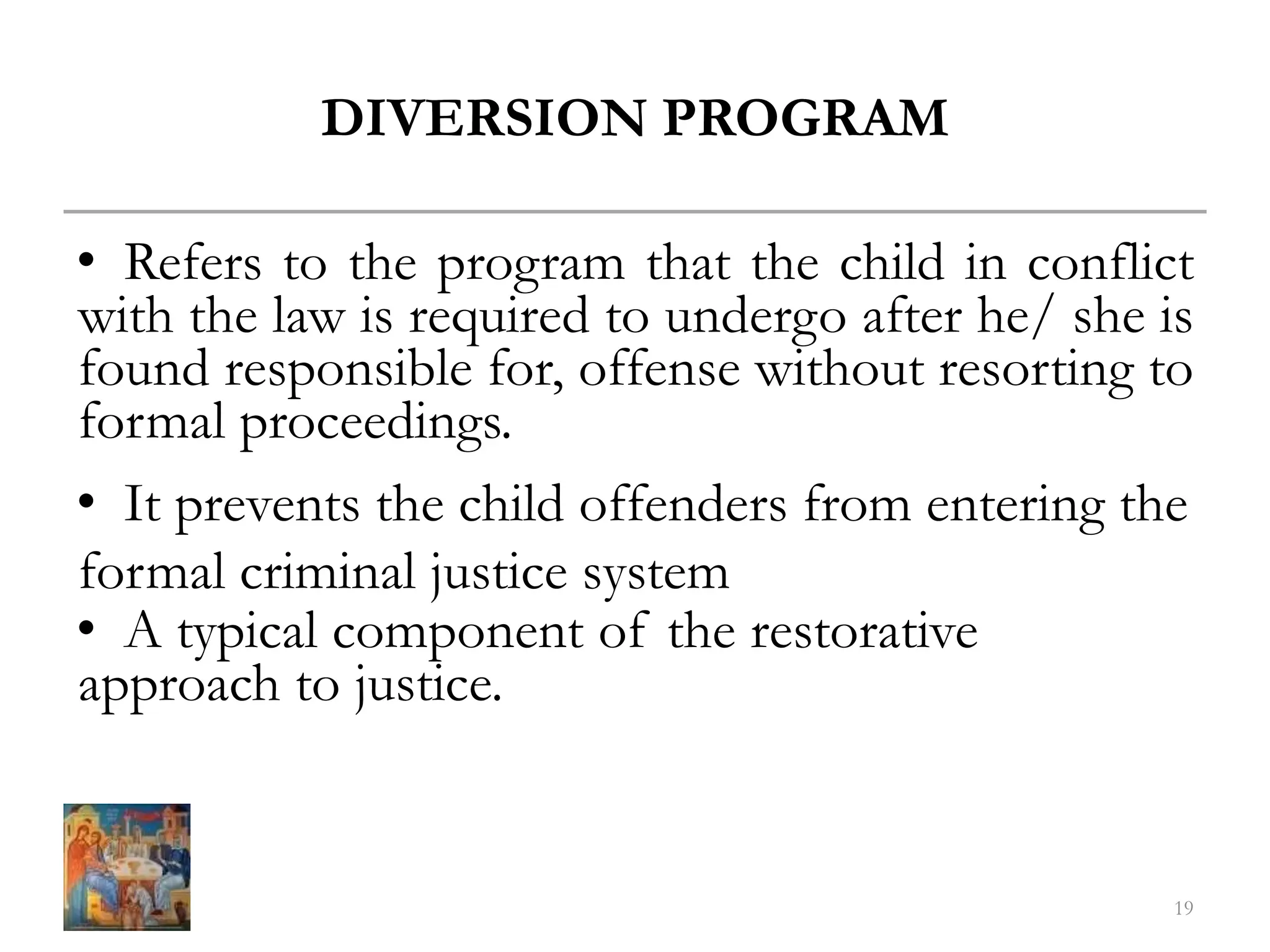
![Sec. 3, Section 20 of the same Act, as amended, is
further amended to read as follows:
"SEC. 20. Children IN CONFLICT WITH THE LAW Below the Age
of [Criminal] Responsibility. – If it has been determined that the child
taken into custody is [fifteen (15) years old or] below NINE (9)
YEARS OF AGE, the authority which will have an initial contact
with the child, in consultation with the local social welfare and
development officer, has the duty to immediately release the child
to the custody of his/her parents or guardian, or in the absence
thereof, the child’s nearest relative. The child shall be subjected to a
community-based intervention program supervised by the local
social welfare and development officer, [unless the best interest of
the child] requires the referral of the child to a youth care facility or
‘Bahay Pag-asa’ managed by LGUs or licensed and/or accredited
NGOs monitored by the DSWD].
20](https://image.slidesharecdn.com/powerpoint-role-of-proposedamendmentstojuvenilejusticeandwelfareact-240424130741-7accdb12/75/powerpoint-role-of-proposed-amendments-to-Juvenile-Justice-and-Welfare-Act-ppt-20-2048.jpg)
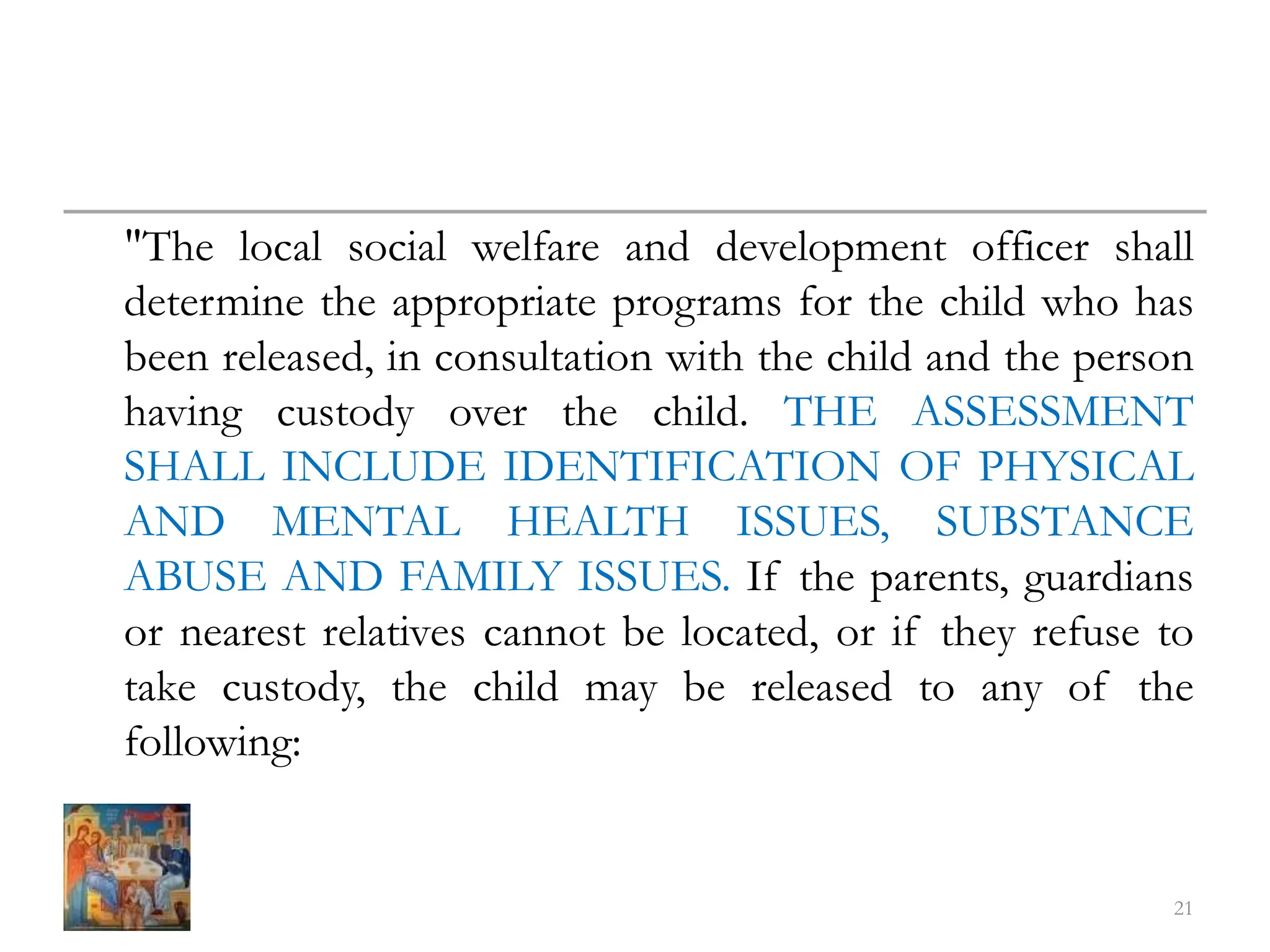
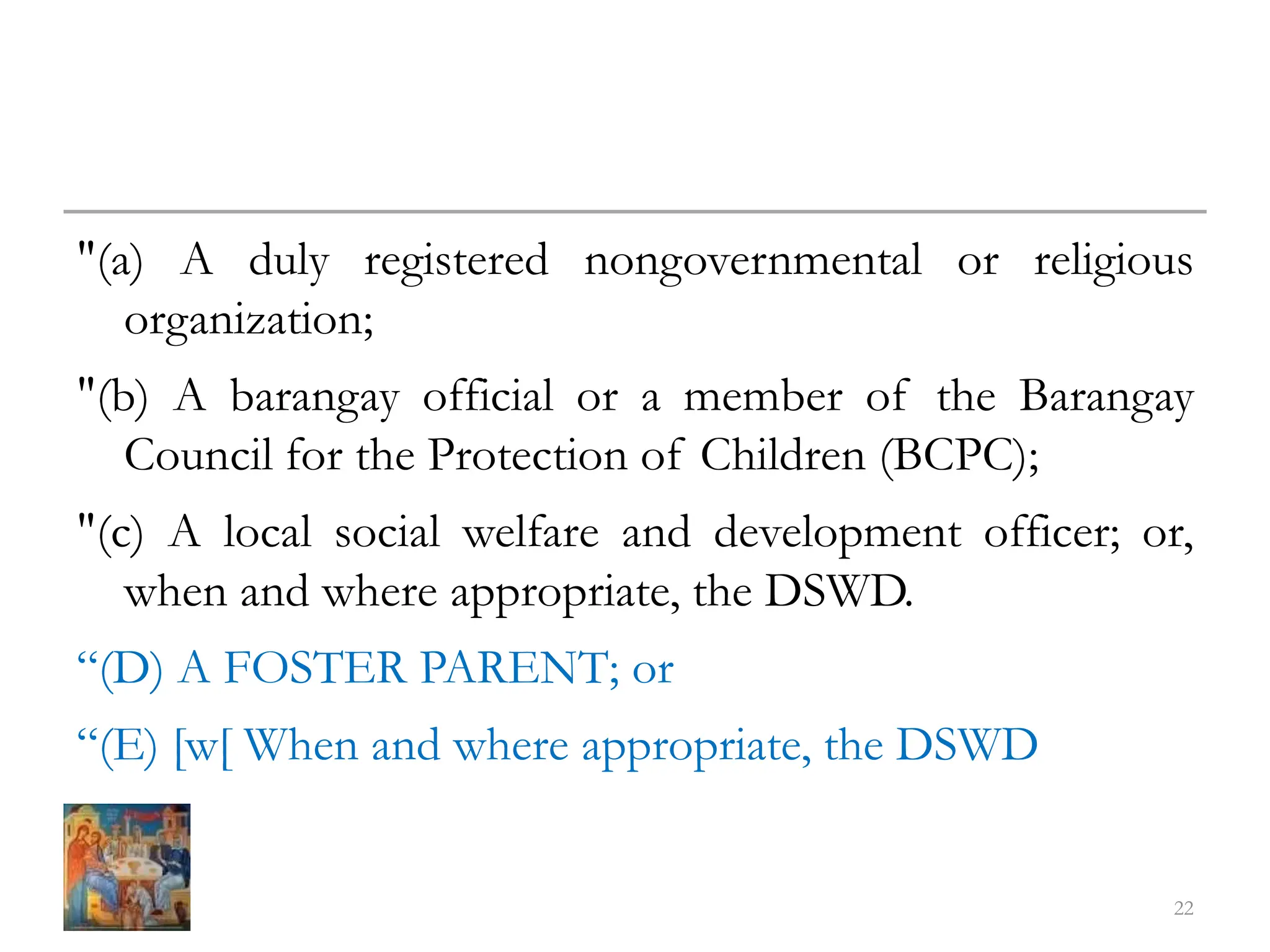
![Sec. 4, Section 20-A of the same Act, as amended,
is further amended to read as follows:
"SEC. 20-A. Serious Crimes Committed by Children IN CONFLICT
WITH THE LAW [Who Are Exempt From Criminal Responsibility]. – A
child who is [above twelve (12) years of age] NINE (9) years of age
up to fifteen (15) years of age and who commits parricide, murder,
infanticide, kidnapping and serious illegal detention where the victim is
killed or raped, robbery, with homicide or rape, destructive arson, rape,
or carnapping where the driver or occupant is killed or raped or
offenses under Republic Act No. 9165 (Comprehensive Dangerous
Drugs Act of 2002) punishable by more than twelve (12) years of
imprisonment, shall be deemed a neglected child under Presidential
Decree No. 603, as amended, and shall be mandatorily placed in a
special facility within the youth care faculty or ‘Bahay Pag-asa’ called
the Intensive Juvenile Intervention and Support Center (IJISC).
23](https://image.slidesharecdn.com/powerpoint-role-of-proposedamendmentstojuvenilejusticeandwelfareact-240424130741-7accdb12/75/powerpoint-role-of-proposed-amendments-to-Juvenile-Justice-and-Welfare-Act-ppt-23-2048.jpg)
![Sec. 5, Section 20-B of the same Act, as amended,
is further amended to read as follows:
"SEC. 20-B. Repetition of Offenses. – A child who is [above
twelve (12) years of age] NINE (9) years of age up to
[fifteen (15) years of age] EIGHTEEN (18) years of
age and who commits an offense for the second time
or oftener: Provided, That the child was previously
subjected to a community-based intervention program,
shall be deemed a neglected child under Presidential
Decree No. 603, as amended, and shall undergo an
intensive intervention program supervised by the local
social welfare and development officer:
24](https://image.slidesharecdn.com/powerpoint-role-of-proposedamendmentstojuvenilejusticeandwelfareact-240424130741-7accdb12/75/powerpoint-role-of-proposed-amendments-to-Juvenile-Justice-and-Welfare-Act-ppt-24-2048.jpg)
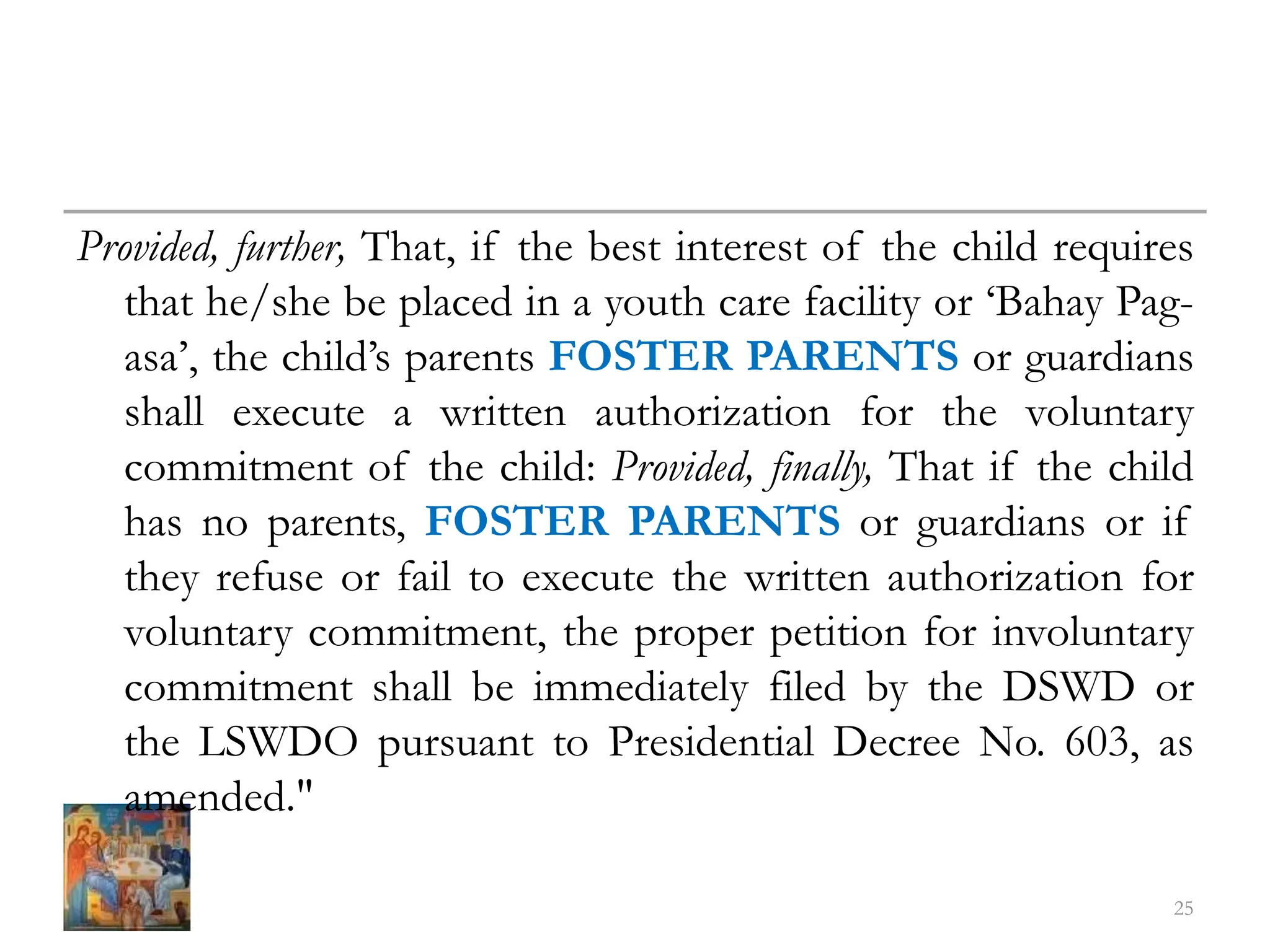
![Sec. 6, Section 20-C of the same Act, as amended,
is further amended to read as follows:
"SEC. 20-C. Exploitation of Children for Commission of
Crimes. – Any person who, in the commission of a
crime, makes use, takes advantage of, or profits
from the use of [children] A CHILD, including any
person who abuses his/her authority over the child
or who, [with abuse of confidence, takes advantage
of the vulnerabilities of the child and shall induce,
threaten or instigate the commission of the crime],
26](https://image.slidesharecdn.com/powerpoint-role-of-proposedamendmentstojuvenilejusticeandwelfareact-240424130741-7accdb12/75/powerpoint-role-of-proposed-amendments-to-Juvenile-Justice-and-Welfare-Act-ppt-26-2048.jpg)
![• OTHERWISE INDUCES OR COERCES A
CHILD TO COMMIT A CRIME, shall be [imposed
the penalty prescribed by law for the crime committed
in its maximum period] PUNISHED BY
RECLUSION TEMPORAL IF THE CRIME
COMMITTED IS PUNISHABLE BY
IMPRISONMENT OF SIX (6) YEARS OR LESS,
AND BY RECLUSION PERPETUA IF THE
CRIME COMMITTED IS PUNISHABLE BY
IMPRISONMENT OF MORE THAN SIX (6)
YEARS."
27](https://image.slidesharecdn.com/powerpoint-role-of-proposedamendmentstojuvenilejusticeandwelfareact-240424130741-7accdb12/75/powerpoint-role-of-proposed-amendments-to-Juvenile-Justice-and-Welfare-Act-ppt-27-2048.jpg)
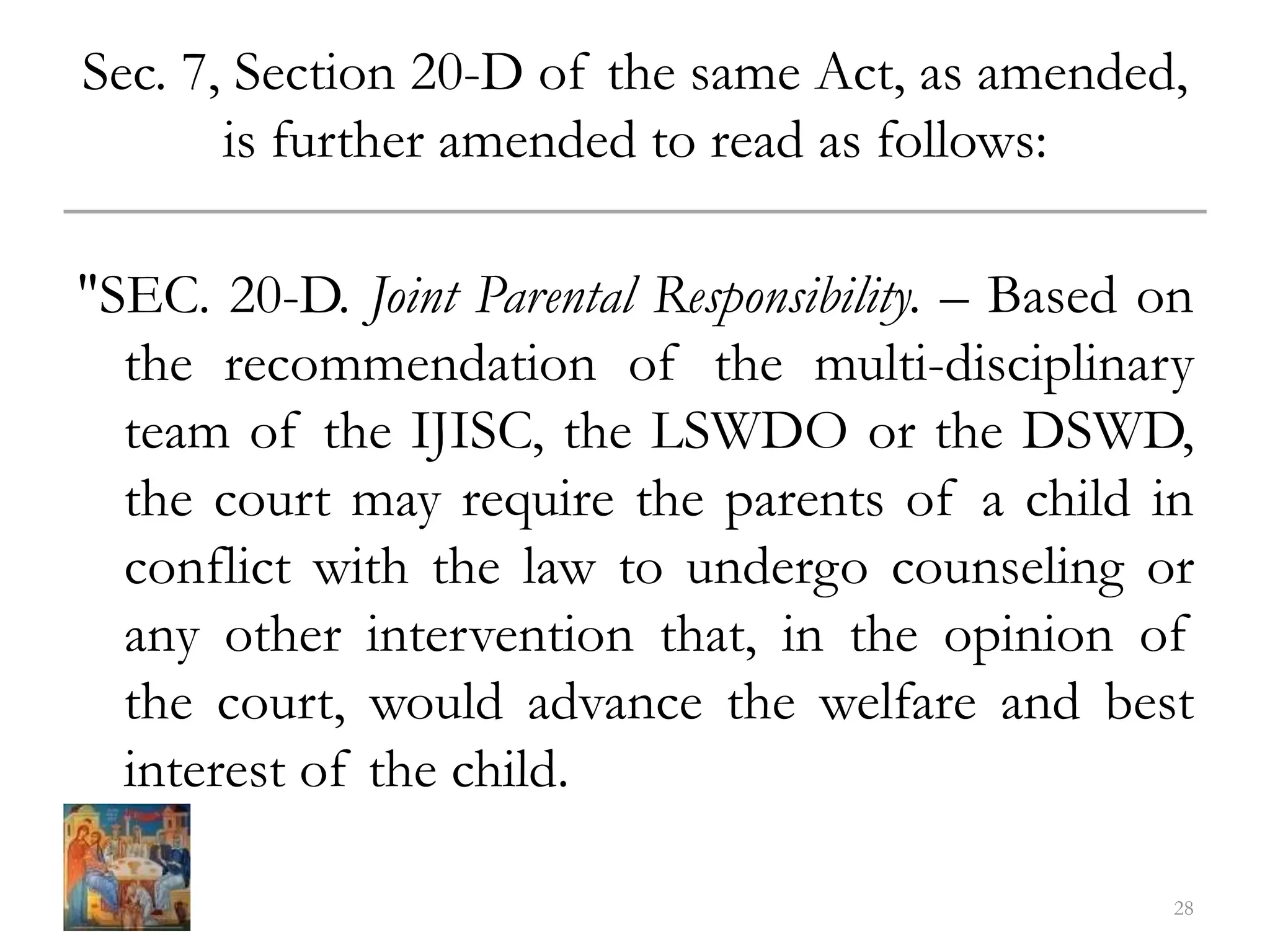
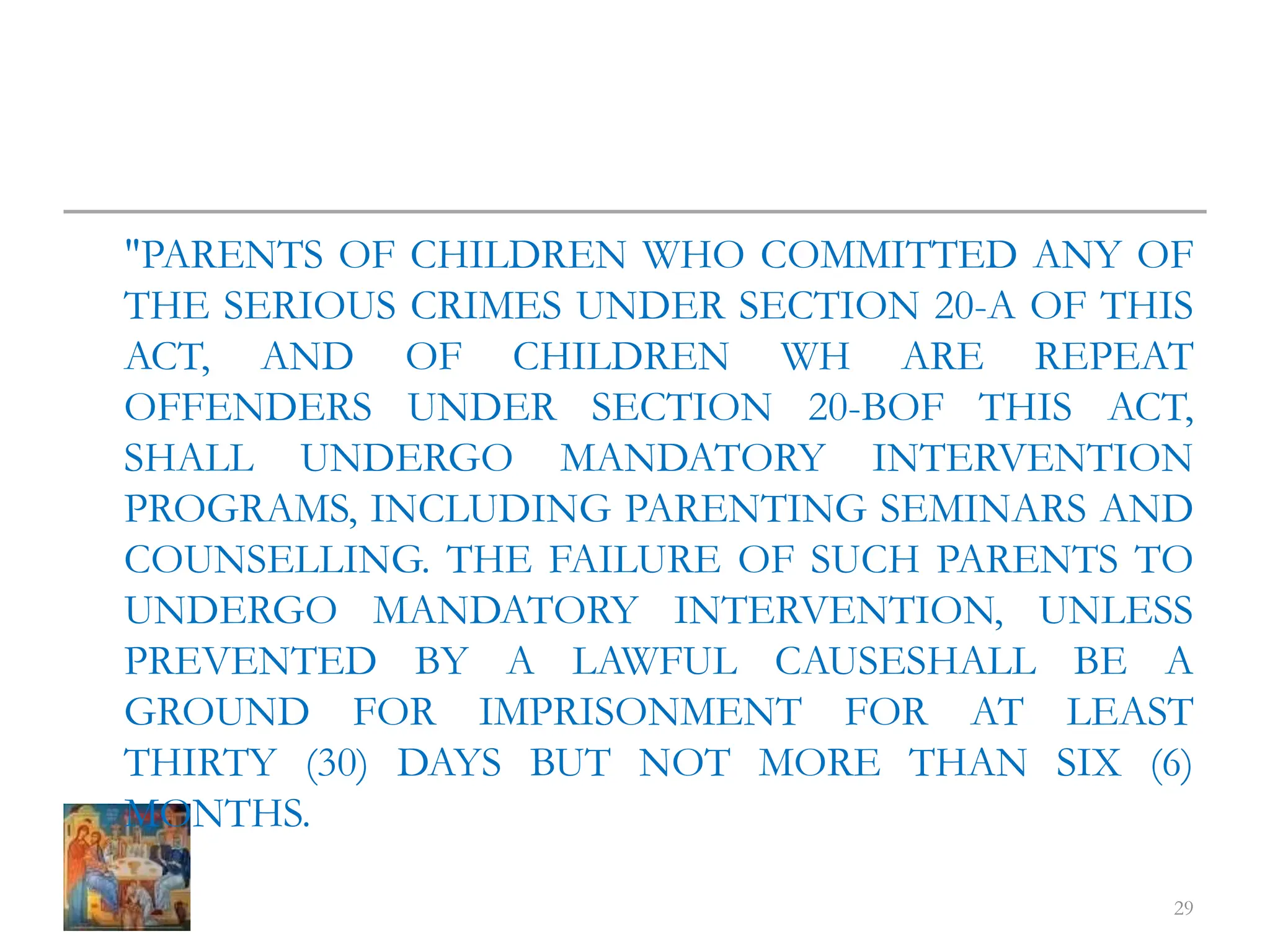
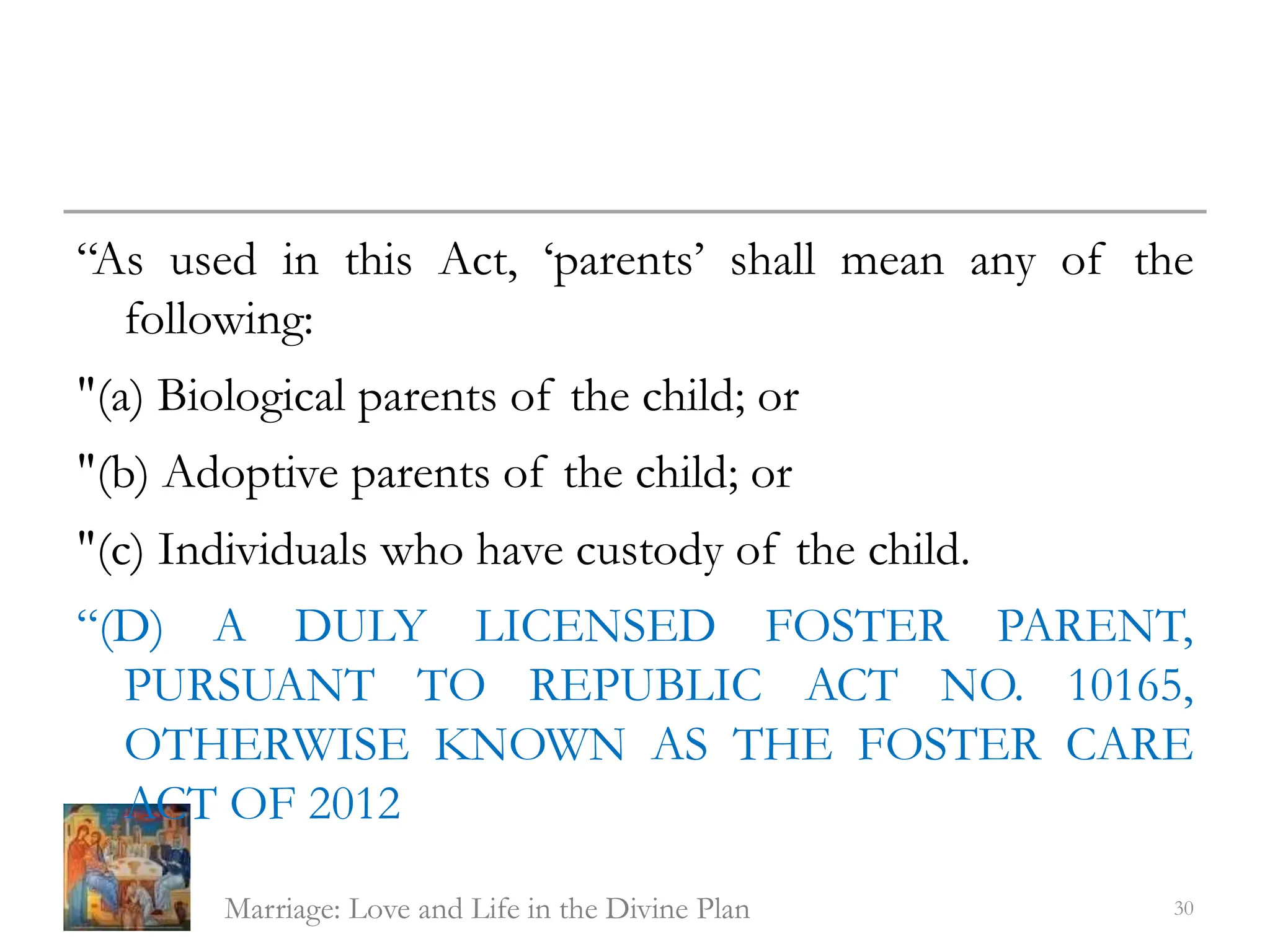
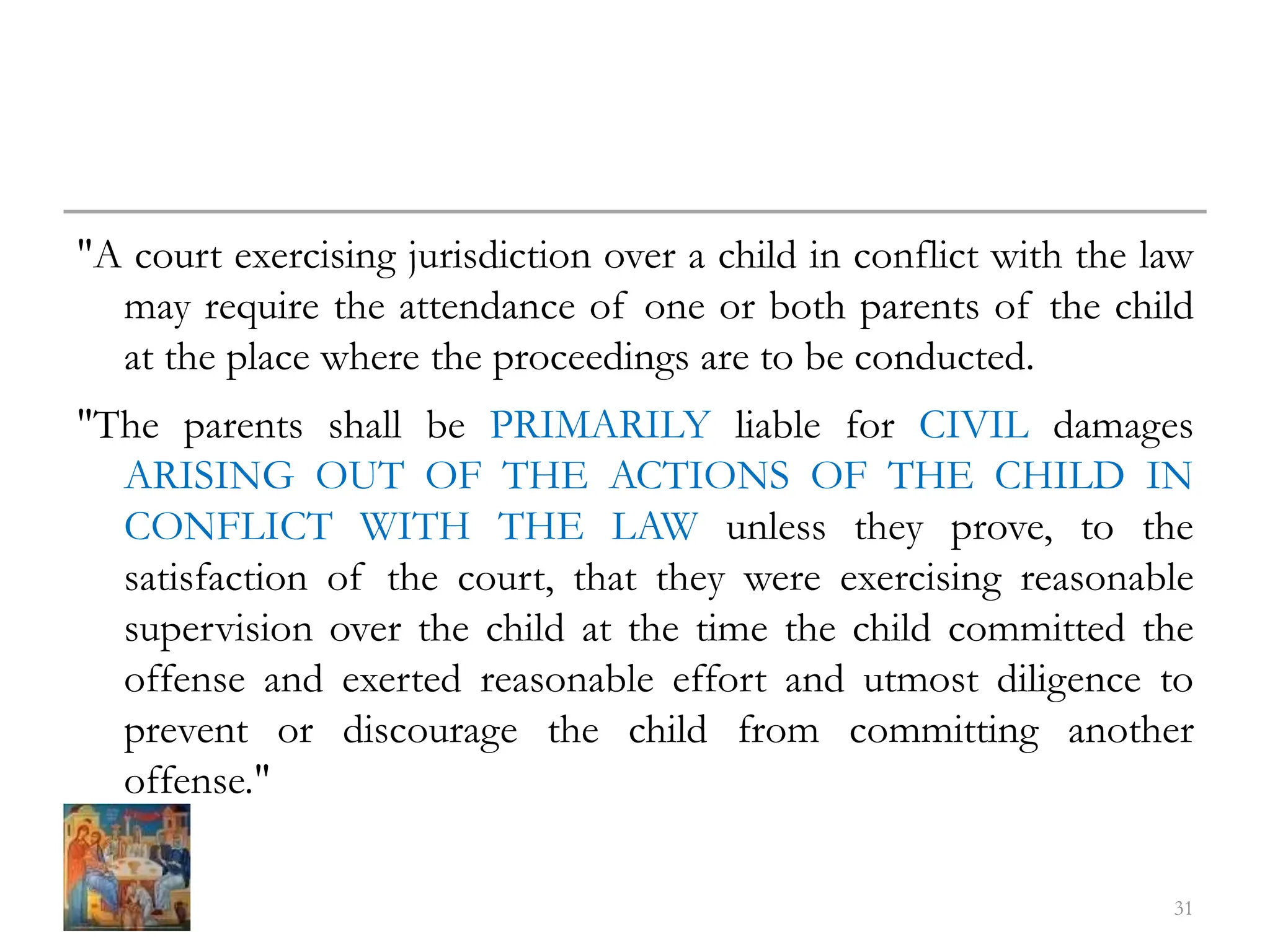

!["The LOCAL social [worker] WELFARE AND
DEVELOPMENT OFFICER shall conduct an initial
assessment to determine the appropriate interventions
and whether the child acted with discernment, using the
discernment assessment tools developed by the DSWD.
The initial assessment shall be without prejudice to the
preparation of a more comprehensive case study
report. The local social [worker] WELFARE AND
DEVELOPMENT OFFICER shall do either of the
following:
33](https://image.slidesharecdn.com/powerpoint-role-of-proposedamendmentstojuvenilejusticeandwelfareact-240424130741-7accdb12/75/powerpoint-role-of-proposed-amendments-to-Juvenile-Justice-and-Welfare-Act-ppt-33-2048.jpg)
!["(a) Proceed in accordance with Section 20 if the child is
[fifteen (15) years or] below NINE (9) YEARS OF
AGE or [above fifteen (15)] NINE (9) YEARS OF
AGE AND ABOVE but below eighteen (18) years
[old] OF AGE, who acted without discernment; and
"(b) If the child is [above fifteen (15) years old] NINE (9)
YEARS OF AGE AND ABOVE but below eighteen
(18) YEARS OF AGE and who acted with discernment
OR COMMITTED A SERIOUS OFFENSE UNDER
SECTION 20-A OF THIS ACT, proceed to diversion
under the following chapter."
34](https://image.slidesharecdn.com/powerpoint-role-of-proposedamendmentstojuvenilejusticeandwelfareact-240424130741-7accdb12/75/powerpoint-role-of-proposed-amendments-to-Juvenile-Justice-and-Welfare-Act-ppt-34-2048.jpg)
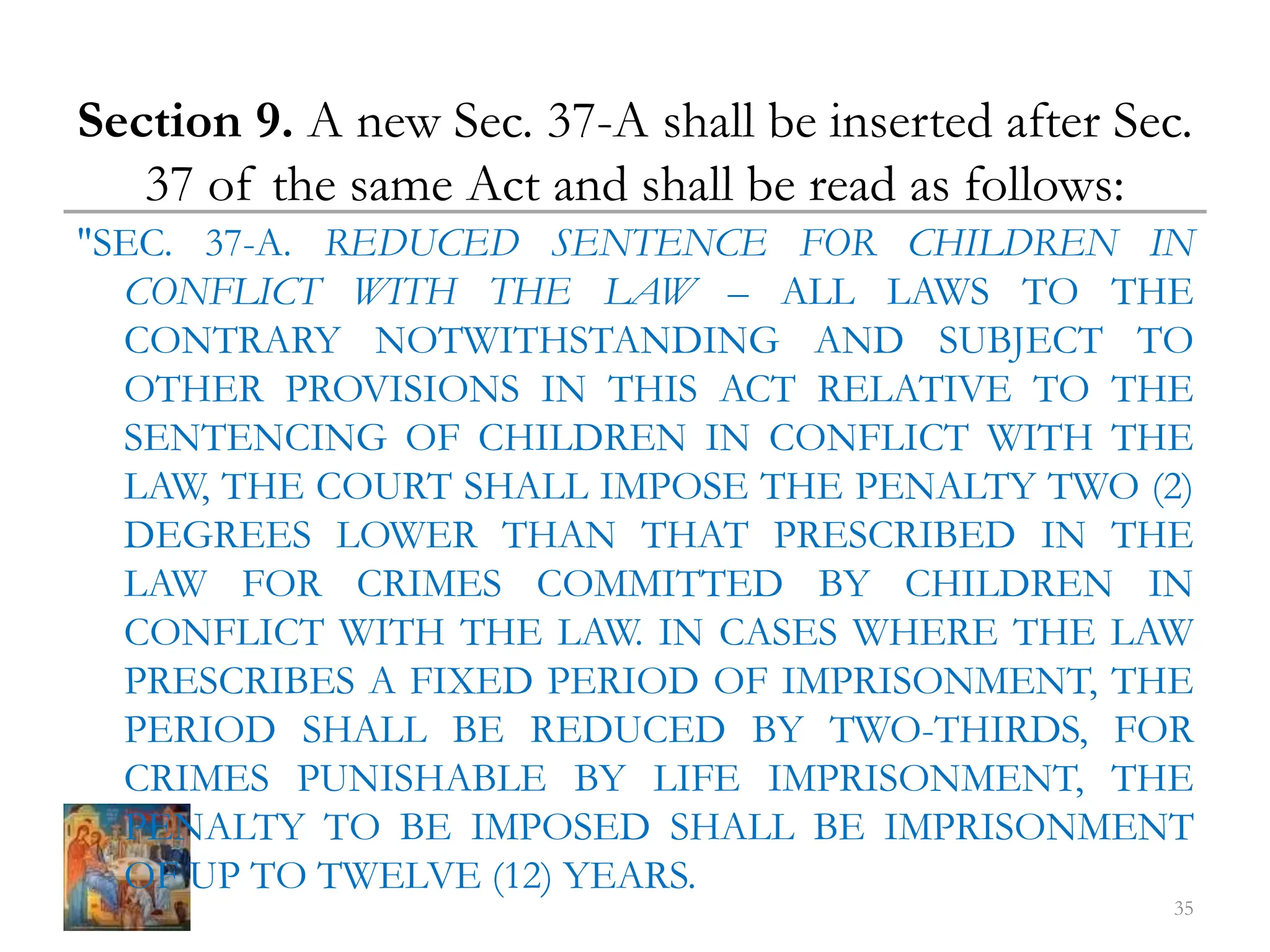
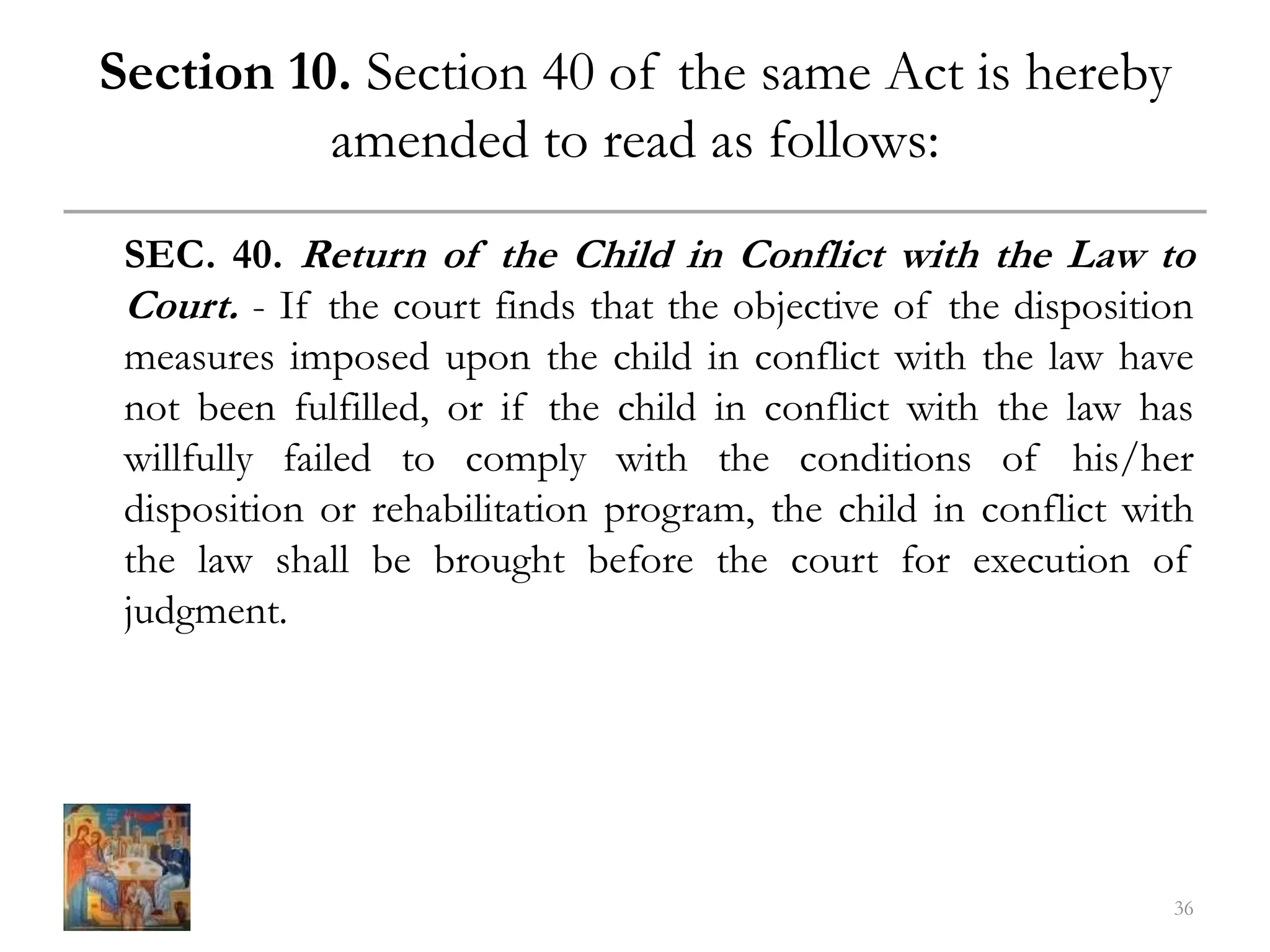
![If said child in conflict with the law has reached
eighteen (18) years of age while under suspended
sentence, the court shall determine whether to
discharge the child in accordance with this Act, to order
execution of sentence, or to extend the [suspended]
SUSPENSION OF THE sentence for a certain
specified period or until the child reaches the maximum
age of [twenty-one (21) years] TWENTY FIVE (25)
years.
37](https://image.slidesharecdn.com/powerpoint-role-of-proposedamendmentstojuvenilejusticeandwelfareact-240424130741-7accdb12/75/powerpoint-role-of-proposed-amendments-to-Juvenile-Justice-and-Welfare-Act-ppt-37-2048.jpg)
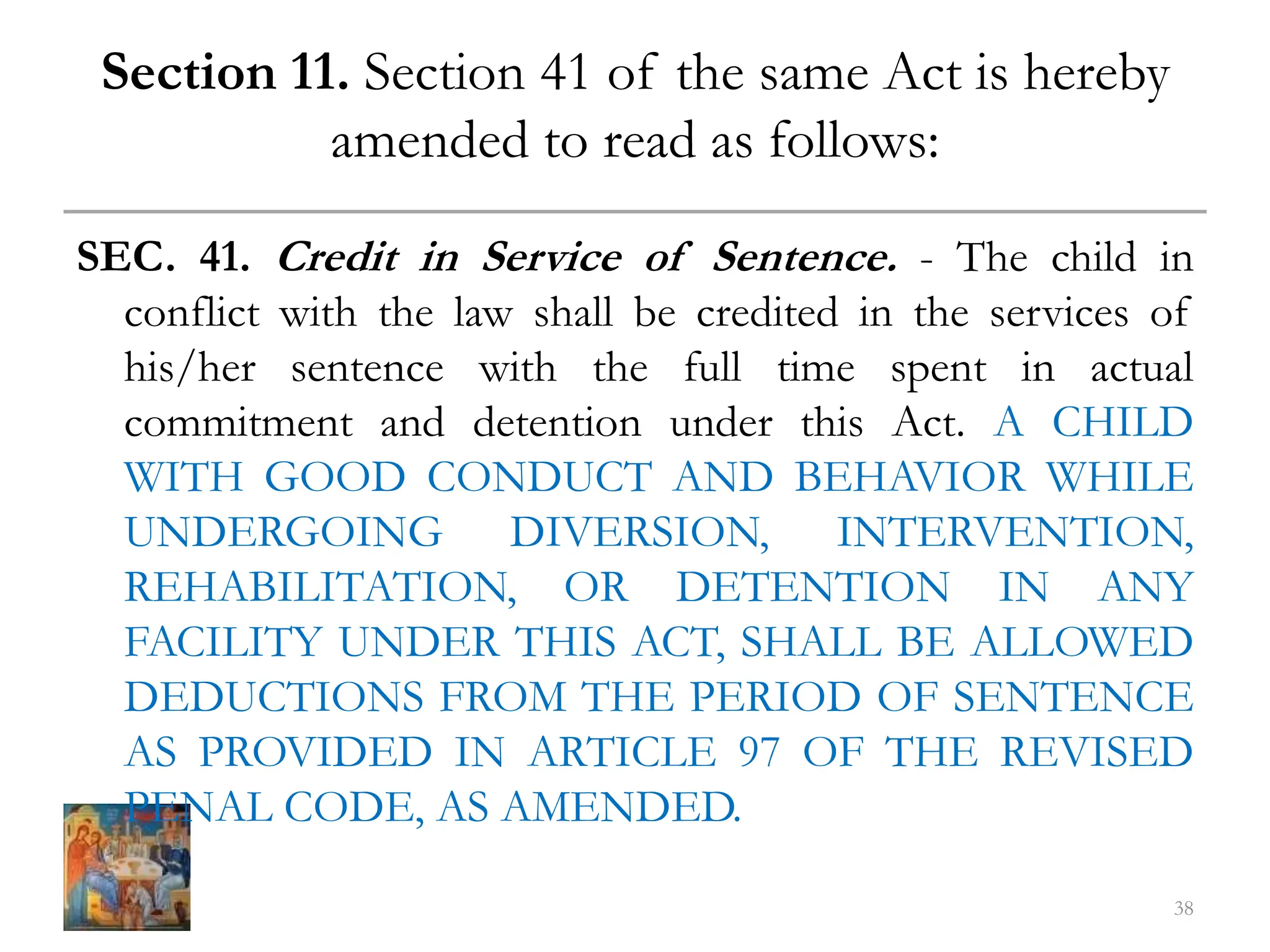
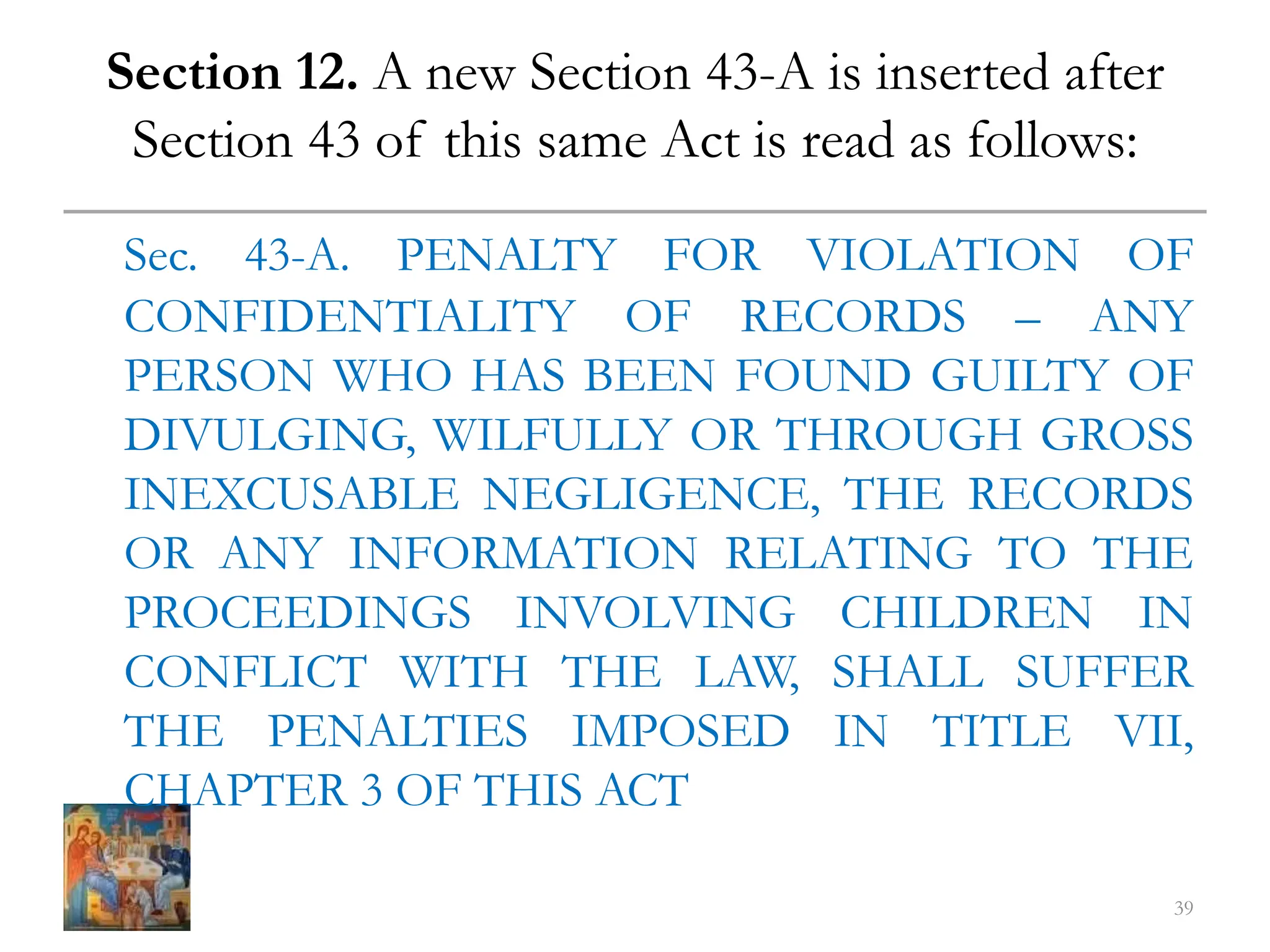
![Section 13. Section 49 of the same Act, is further
amended to read as follows:
"SEC. 49. Establishment of ‘Bahay Pag-Asa’. – [Each
province and highly-urbanized city (the LGUs)]
THE DSWD shall be responsible for building,
funding and operating a ‘Bahay Pag-asa’ [within
their jurisdiction] IN PROVINCES AND
CITIES TO BE IDENTIFIED BY THE JJWC
following the standards that will be set by the
DSWD and adopted by the JJWC.
40](https://image.slidesharecdn.com/powerpoint-role-of-proposedamendmentstojuvenilejusticeandwelfareact-240424130741-7accdb12/75/powerpoint-role-of-proposed-amendments-to-Juvenile-Justice-and-Welfare-Act-ppt-40-2048.jpg)
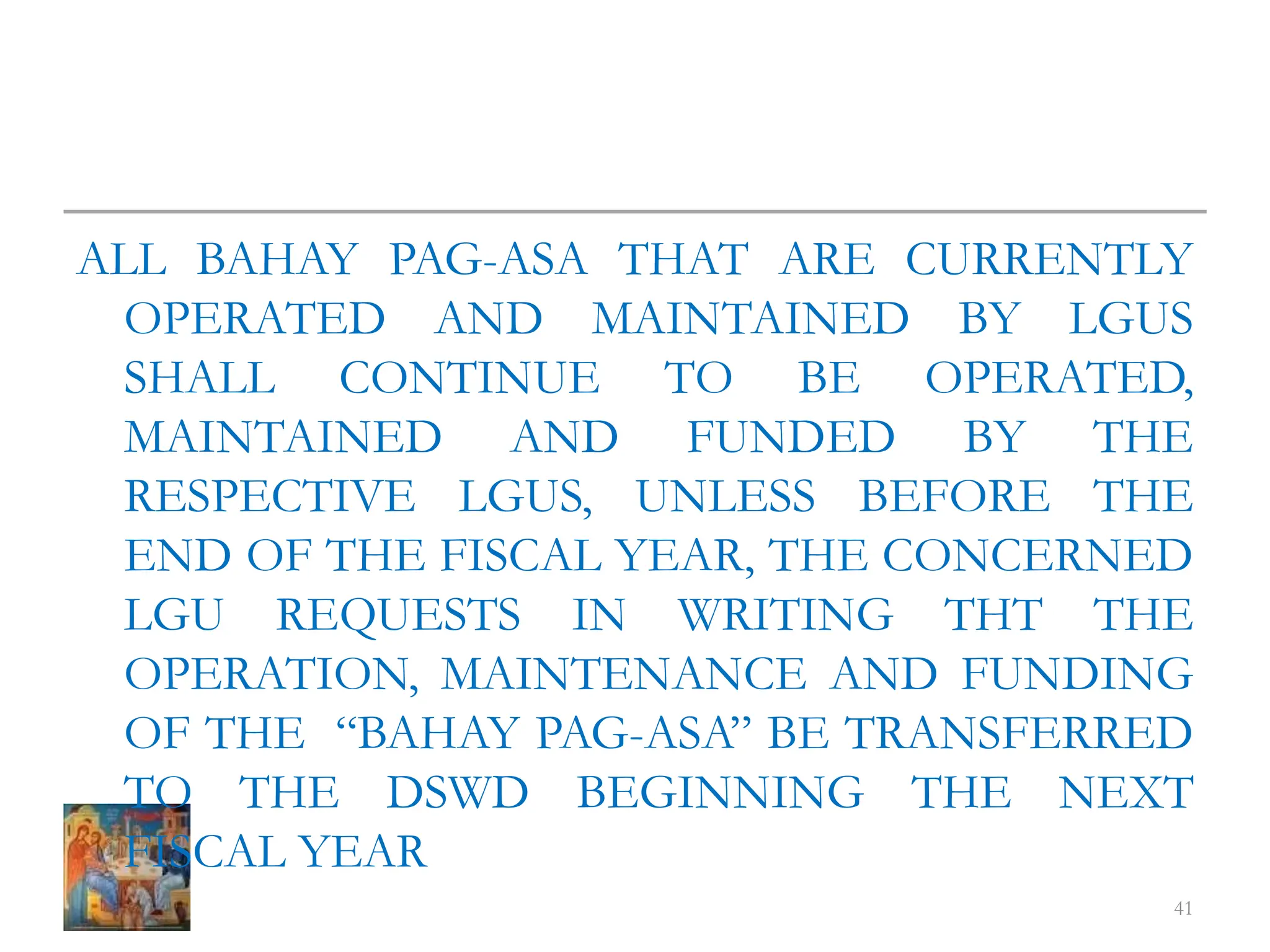
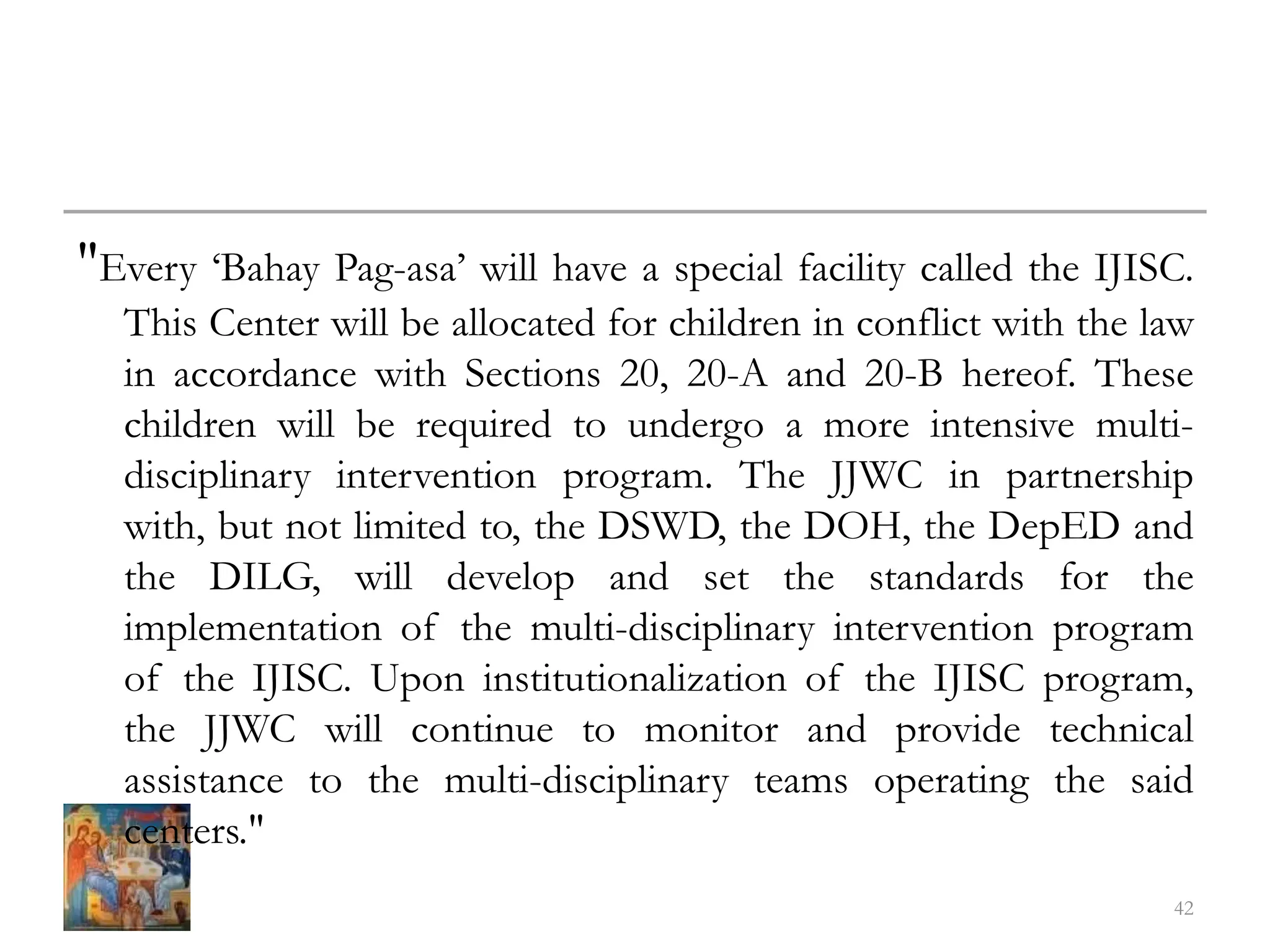

![Section 14. Section 51 of the same Act is hereby
amended to read as follows:
SEC. 51. Confinement of Convicted Children in
Agricultural Camps and other Training Facilities. - A
child in conflict with the law [may] SHALL, after conviction
and upon order of the court, be made to serve his/her
sentence, in lieu of confinement in a regular penal
institution, in an agricultural camp and other training
facilities that [may] SHALL be established, maintained,
supervised and controlled by the [BUCOR] DSWD, in
[coordination] PARTNERSHIP with the [DSWD] BUCOR
AND THE TECHNICAL EDUCATION AND SKILLS
DEVELOPMENT AUTHORITY (TESDA).
44](https://image.slidesharecdn.com/powerpoint-role-of-proposedamendmentstojuvenilejusticeandwelfareact-240424130741-7accdb12/75/powerpoint-role-of-proposed-amendments-to-Juvenile-Justice-and-Welfare-Act-ppt-44-2048.jpg)
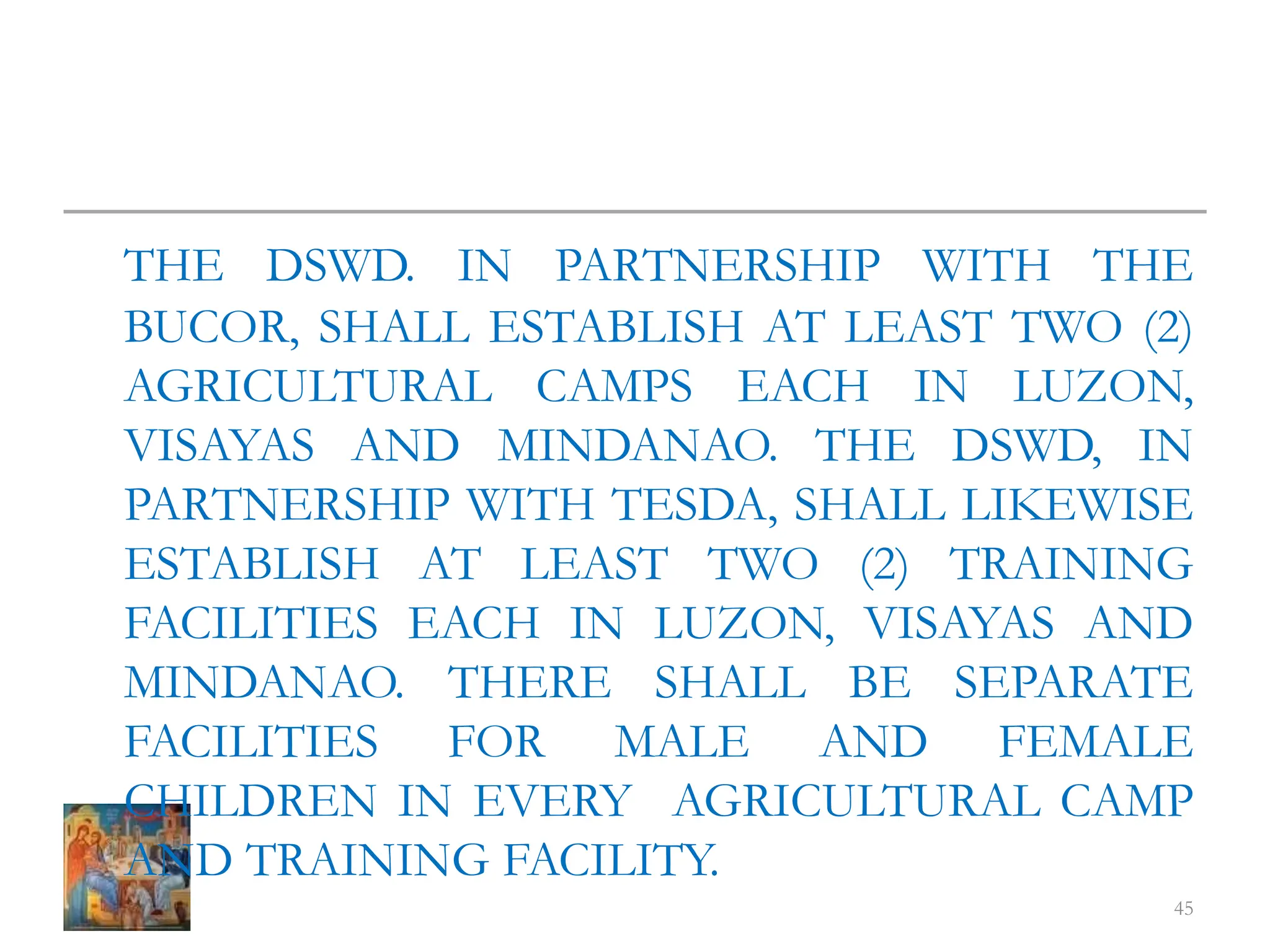
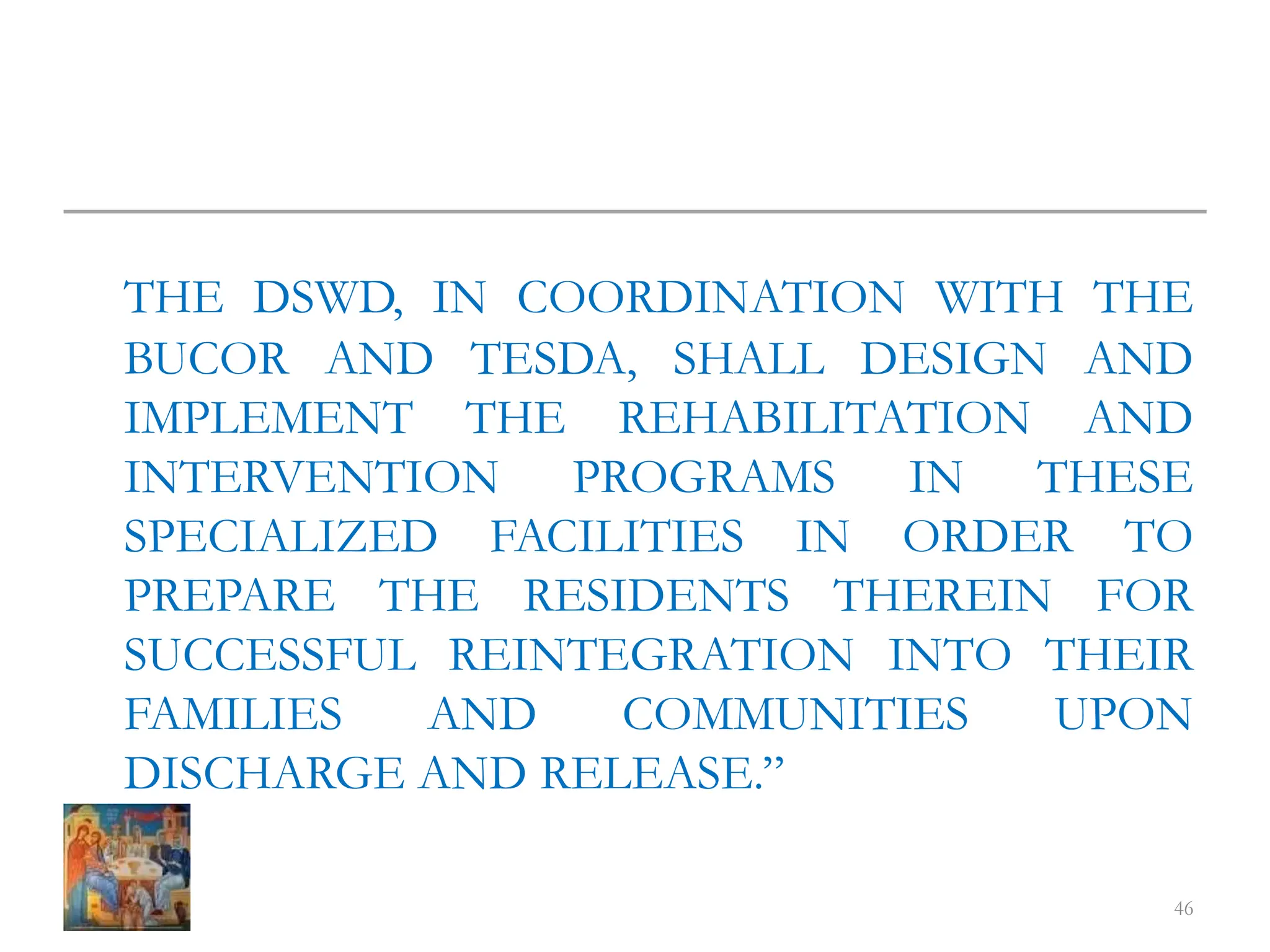
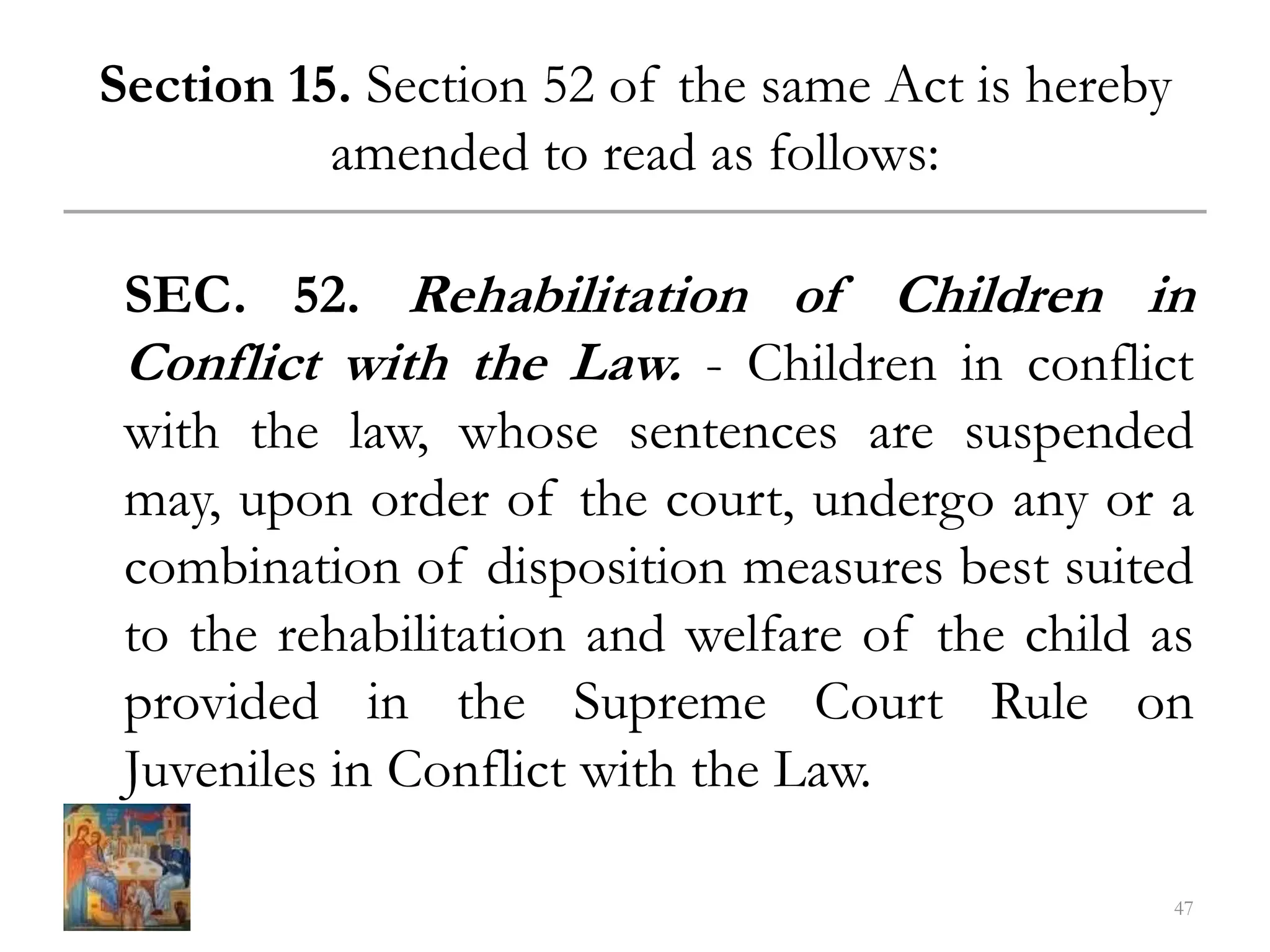
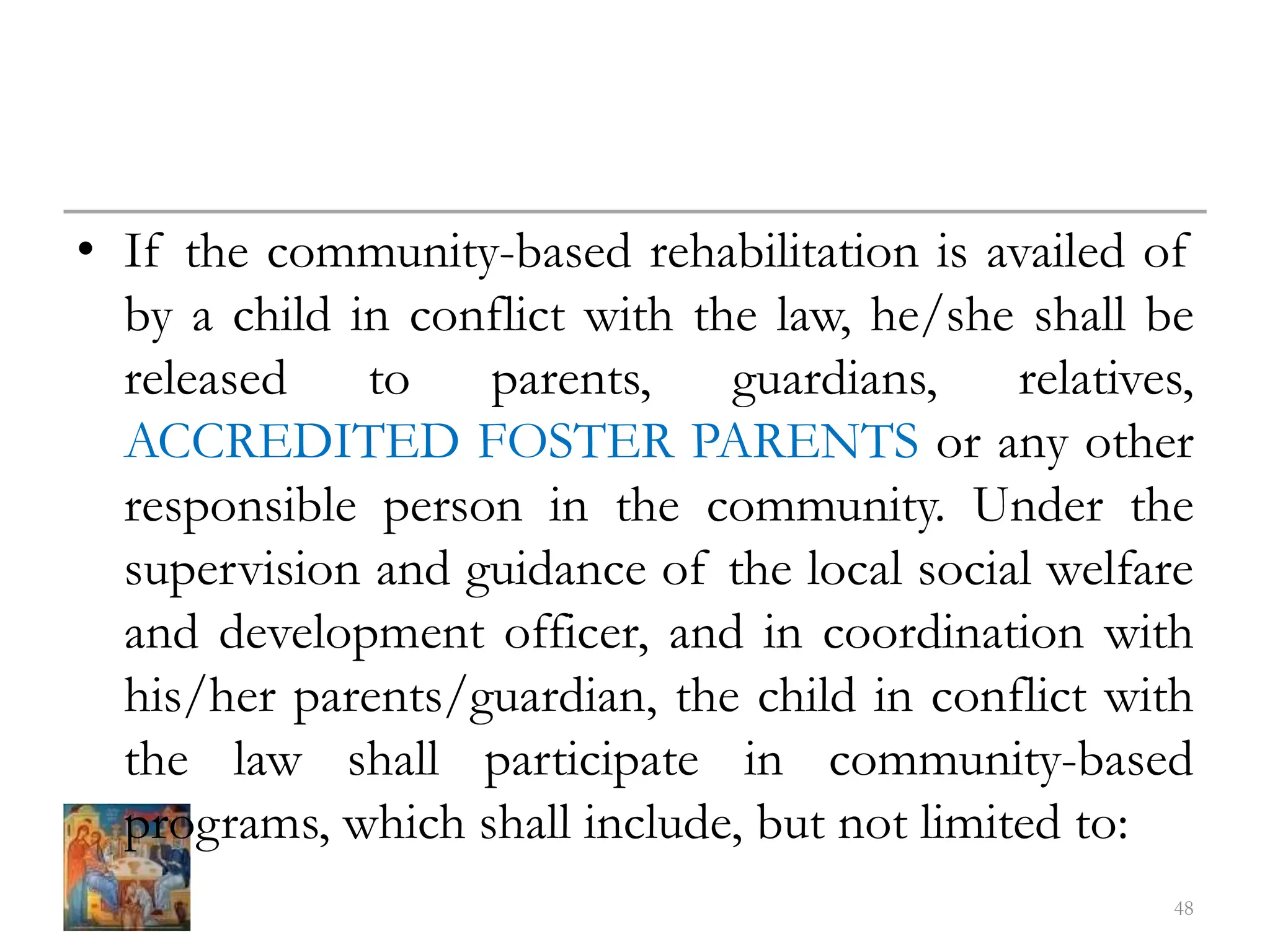
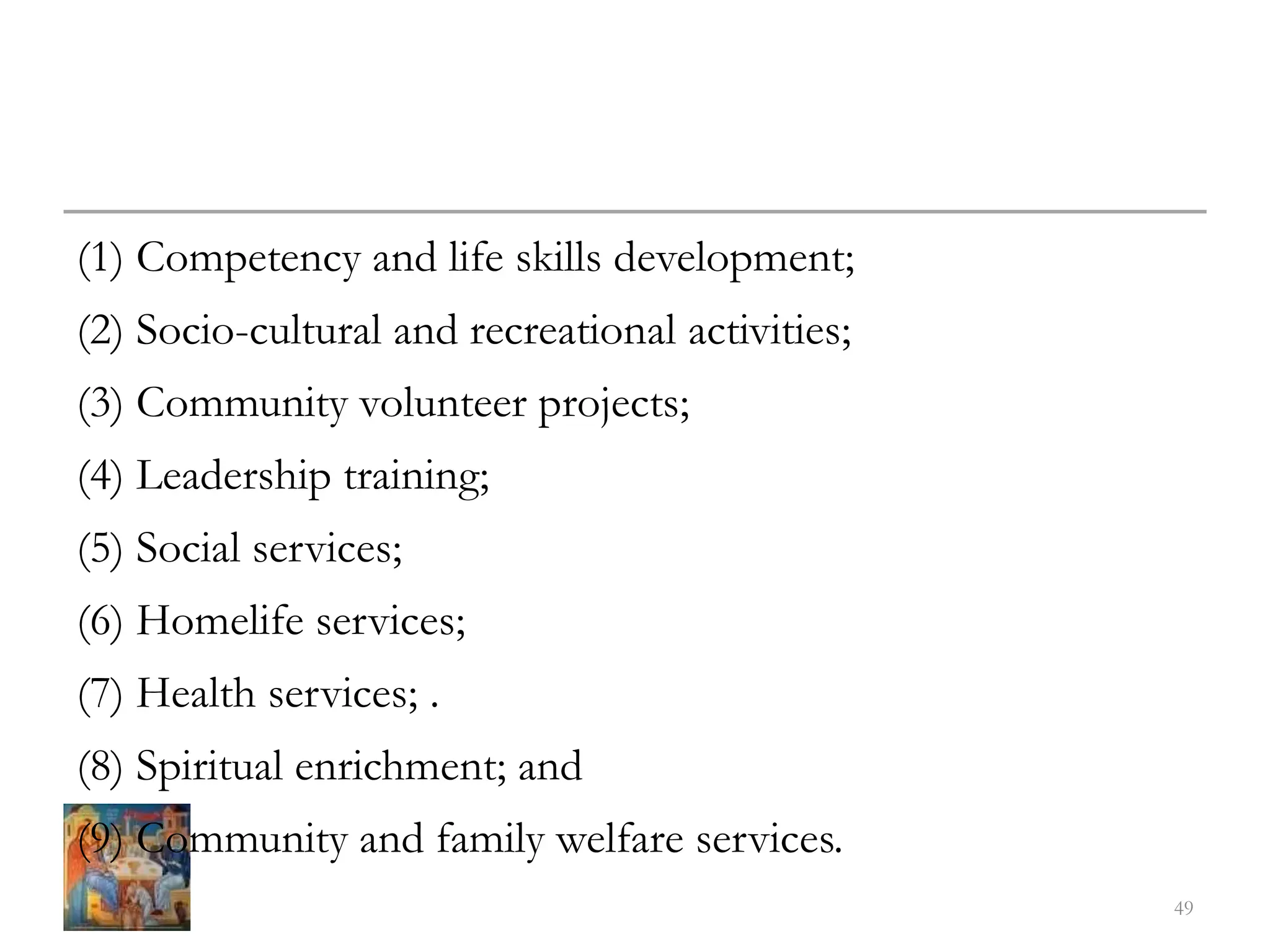
![Section 16. Section 64 of the same Act is hereby
amended to read as follows:
SEC. 64. Children in Conflict with the Law [Fifteen (15) Years
Old and] Below NINE (9) YEARS OF AGE. - Upon effectivity
of this Act, cases [of children fifteen (15) years old and]
INVOLVING CHILDREN IN CONFLICT WITH THE LAW
below NINE (9) YEARS OF AGE at the time of the commission
of the crime shall immediately be dismissed and the child shall be
referred to the appropriate local social welfare and development
officer. Such officer, upon thorough assessment of the child, shall
determine whether to release the child to the custody of his/her
parents, or refer the child to prevention programs as provided
under this Act. Those with suspended sentences and undergoing
rehabilitation at the youth rehabilitation center shall likewise be
released, unless it is contrary to the best interest of the child.
50](https://image.slidesharecdn.com/powerpoint-role-of-proposedamendmentstojuvenilejusticeandwelfareact-240424130741-7accdb12/75/powerpoint-role-of-proposed-amendments-to-Juvenile-Justice-and-Welfare-Act-ppt-50-2048.jpg)
